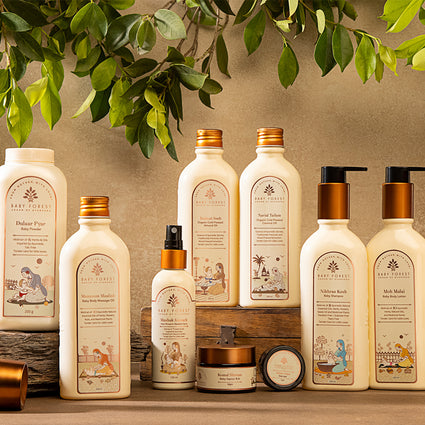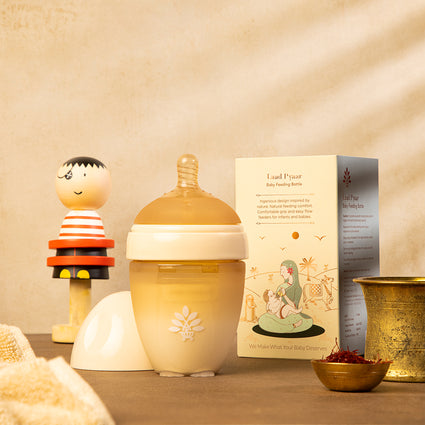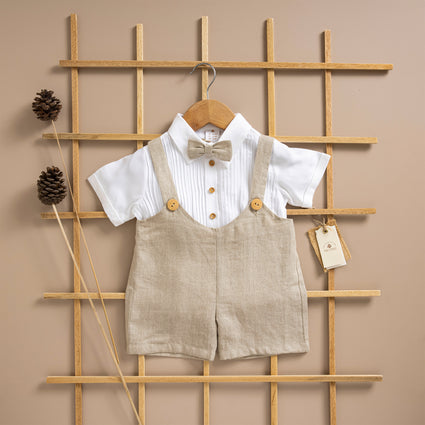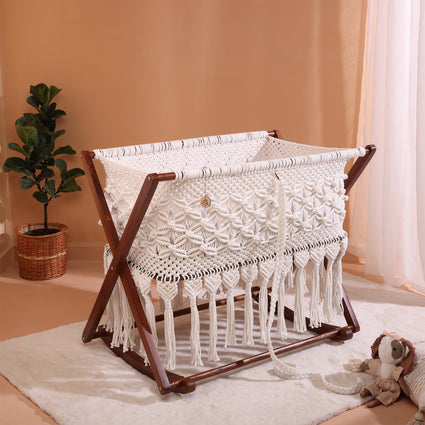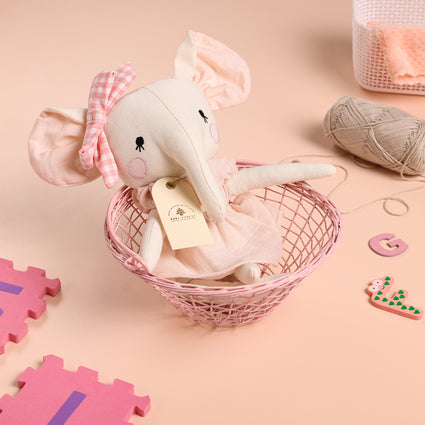Baby Care & Parenting Blogs
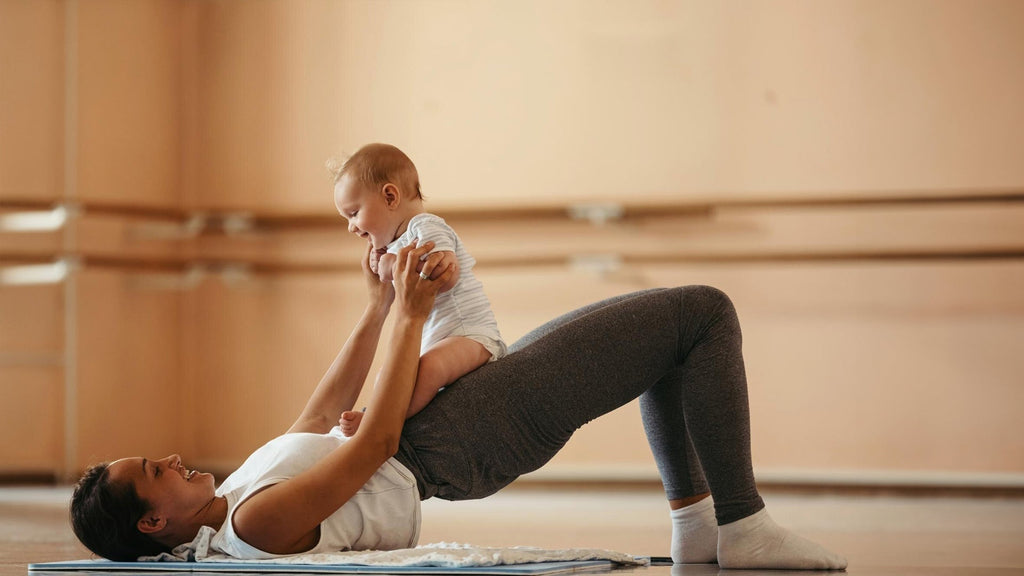
A Parent’s Guide to Dressing Your Baby for Cold Weather
Winter brings its own charm, with chilly breezes and cosy moments. But for parents, it also brings the challenge of keeping their little ones warm and comfortable. Babies, especially newborns, are more sensitive to cold weather because they can’t regulate their body temperature as well as adults. So, knowing how to dress your baby properly for the cold is essential to keep them snug, safe, and happy.
This guide will walk you through the essentials of dressing your baby for cold weather, ensuring they stay cosy without feeling overheated or uncomfortable.
When it comes to dressing your baby for winter, keeping them warm and cozy doesn’t have to mean piling on too many layers. The key is to choose clothing that provides full coverage and warmth without needing excessive layering.
Start with a single warm outfit, like a Full Sleeves Baby Bodysuit, a Hoodie Romper Set, or a Baby Overall Romper Set. These options are designed to cover your baby’s arms, legs, and feet, often including attached socks and mittens, so they’re well-protected from the cold.
If it’s particularly chilly or you’re stepping outside, add an extra layer like a Kashmiri Pashmina Baby Blanket to wrap them snugly. This provides an additional shield against the cold without making your baby feel restricted or overheated. Remember, it’s all about keeping them comfortable while ensuring they’re safe from the winter chill.

-
Choose the Right Materials
The type of fabric you choose for your baby’s winter wardrobe can make a big difference in keeping them comfortable. Here are some fabrics to prioritize:Cotton:
Perfect for base layers like bodysuits, as it’s soft, breathable, and gentle on sensitive skin.Wool or Fleece:
Ideal for outer layers, these materials provide excellent insulation. Look for fleece-lined rompers like the Hoodie Romper Set for extra warmth.Pashmina:
A premium choice for blankets, offering warmth without bulk.Knitted Wool:
Great for hats and mittens, as it’s warm yet breathable.
Avoid synthetic materials that can irritate your baby’s skin or cause overheating. -
Dressing for Sleep
Nighttime can be tricky when it comes to keeping your baby warm. You want to ensure they’re snug but not too hot. Start with a Full Sleeves Baby Bodysuit as the base layer, followed by a lightweight sleep sack or swaddle.

Always check the temperature of the room and avoid heavy bedding like quilts, which can pose a suffocation risk. A safe sleep environment is just as important as keeping your baby warm. -
Keep an Eye on Overheating
While it’s crucial to keep your baby warm, it’s equally important to avoid overheating. Overdressing can make your baby uncomfortable and increase the risk of heat rashes or even more serious issues. Signs of overheating include sweating, flushed cheeks, or a damp neck.
A simple rule to follow is the one-layer rule: dress your baby in one more layer than what you’re wearing to stay comfortable in the same temperature. -
Protect Their Head and Ears
Babies lose a lot of heat through their heads, so don’t forget a soft, snug-fitting hat. If you’re heading outdoors, ensure their ears are covered to prevent them from getting too cold. Many rompers, like the Hoodie Romper Set, come with attached hoods that can be used for added warmth. -
Check Comfort Regularly
Even when your baby looks cosy, it’s essential to check how they’re feeling. Feel their chest or back (not hands or feet, as they can naturally feel cooler) to ensure they’re warm but not sweaty. Adjust their clothing or layers accordingly.
Final Thoughts
Dressing your baby for winter isn’t just about keeping them warm; it’s about making sure they feel cozy, comfortable, and cared for. Don’t worry if you’re still figuring it out—dressing your baby is something you’ll get better at with time. Enjoy the snuggles, the giggles, and those quiet moments as you wrap them up against the cold.

Top Tips for Choosing the Safest and Most Comfortable Bab...
A baby cot is more than just a piece of furniture—it's a haven where your baby will spend a significant amount of time sleeping, resting, and growing. Choosing the right cot can feel overwhelming with so many options available, but focusing on safety and comfort will help you make the best decision.
Here are some practical tips to guide you in selecting the safest and most comfortable baby cot for your precious one.
-
Prioritize Safety Standards
When it comes to baby furniture, safety is non-negotiable. So firstly, we see to it that the baby cot meets established safety standards.Sturdy Frame:
The cot should feel stable and not wobble when gently pushed. A durable frame minimizes the risk of accidents.Safe Gaps Between Slats:
Ensure the gaps between the slats are less than 6 cm to prevent the baby’s arms, legs, or head from getting stuck.Rounded Edges:
The cot should have smooth, rounded edges to avoid injuries. No sharp corners or exposed nails!
-
Choose Leak-Proof and Easy-to-Clean Materials
Babies are messy; it's just part of their charm! A leak-proof cot mattress and easy-to-clean materials can save you a lot of hassle.
Look for cots with water-resistant mattresses or covers that can be wiped clean easily. These are great for unexpected spills, diaper leaks, or baby drool.
Avoid materials that stain easily or require complicated cleaning procedures. Remember, convenience is key when dealing with babies. -
Go for Adjustable Height Features
An adjustable height cot is a lifesaver for parents. It grows with your baby and ensures that the cot remains practical as your little one transitions from newborn to toddler.Newborn Stage:
A higher mattress setting allows you to place your baby in the cot without bending too much, saving your back.Toddler Stage:
As your baby becomes more active, a lower mattress setting ensures they can’t climb out and risk falling.
This flexibility makes adjustable cots a great long-term investment. -
Opt for Natural and Non-Toxic Materials
Babies are sensitive, and their skin can react to harsh chemicals. Choosing a cot made from natural and non-toxic materials is essential for their safety and comfort.Natural Wood:
Look for cots made from solid wood like teak, pine, or rubberwood. They’re not only durable but also free from harmful chemicals.Non-Toxic Paints and Finishes:
Ensure the paint and finishes used on the cot are lead-free and safe for babies, as they might chew on the cot rails when teething.Eco-Friendly Options:
If sustainability is important to you, explore eco-friendly baby cots made from renewable materials. -
Check for Durability and Longevity
A good baby cot should last for years, possibly even for multiple children. Investing in a durable cot makes sure you don’t have to replace it too soon.
Choose cots with a solid construction that can handle the wear and tear of daily use. Avoid lightweight, flimsy materials. -
Pay Attention to Comfort
Your baby’s comfort is just as important as their safety. A comfortable cot encourages better sleep, which is crucial for their development.Firm Mattress:
Opt for a firm and supportive mattress that fits snugly into the cot without any gaps. A well-fitting mattress prevents the baby from slipping into gaps, reducing the risk of injury.Breathable Bedding:
Use lightweight, breathable bedding like cotton sheets to keep your baby comfortable without overheating.Soft Edging:
While the mattress should be firm, soft edges around the cot can enhance comfort and prevent bumps. -
Cot Size
Consider the size of the cot and how it fits into your living space.Standard vs. Compact Size:
A standard-size cot offers more room for the baby to grow, while a compact cot is ideal for smaller spaces or for travel. -
Style and Design
While safety and comfort are priorities, there’s no harm in choosing a cot that complements your home’s décor. Baby cots come in various styles, from classic wooden designs to modern minimalistic ones. Opt for timeless colours like white, beige, or natural wood tones. They blend well with most interiors and never go out of style.
Final Thoughts
Choosing the right baby cot is a big step. Think of it as creating your baby’s first little world—a cozy, safe space where they can sleep, dream, and grow. Take your time while shopping. Read reviews, ask questions, and don’t rush into a decision. The good news is, you don’t have to sacrifice style for practicality—there are plenty of beautiful cots that meet all your needs.
The Baby Forest Kilkari Wooden Baby Cot is a wonderful example of blending safety, comfort, and style. Made from high-quality HDMR wood and natural cane, this cot is thoughtfully designed with eco-friendly materials to ensure a safe, non-toxic space for your little one. The chemical-free, natural paint not only looks beautiful but also prioritizes your baby’s health and well-being. Plus, it comes with a comfortable mattress that features a leak-proof cover—perfect for keeping things clean and cozy.

Celebrate Motherhood with Baby Forest: The Best Baby Prod...
Mother's Day is a time to celebrate and appreciate the incredible women who have shaped our lives with their love and care. For new moms, nothing is more special than providing the best care for their newborns. One way to make this journey easier is by offering high-quality baby care products that ensure the best for their little ones. Baby Forest understands this and offers a range of natural baby care products inspired by the ancient principles of Ayurveda, ensuring both mother and baby receive the gentle, nurturing care they deserve.
If you're looking for the best baby care products for newborns, here are six essential items from Baby Forest's range that every new mom should have for their little ones.
Must Have Baby Care Products
-
Shampoo
Babies have delicate scalps and sensitive skin, so it's crucial to choose the right baby skin care products. A sulfate-free and paraben-free shampoo is ideal for gently cleaning and nourishing your baby's scalp. Harsh chemicals can cause irritation, so opting for a natural baby shampoo that hydrates and strengthens hair is important.
We recommend Baby Forest's Nikhrae Kesh Shampoo, which is rich in Brahmi and Hibiscus leaf extracts, known for strengthening hair roots and promoting scalp hydration. This is a perfect addition to your newborn baby care products list, ensuring your baby's hair stays soft and healthy.
-
Body Massage Oil
An essential part of baby skincare is daily massages, and nothing beats the benefits of a good baby massage oil. Massaging your baby not only promotes relaxation but also aids in muscle development and improves circulation. Ayurvedic oils are particularly effective due to their natural healing properties.
For this, try Baby Forest's Maasoom Maalish Baby Body Massage Oil, which contains Sesame Oil and Rosemary to support bone and muscle development. This oil is a key item in any baby care products kit, offering therapeutic benefits that nourish and soothe your baby's skin.
-
Diaper Rash Cream
With the warmer months approaching, babies are more prone to diaper rashes due to sweating. Diaper rash creams are vital in keeping your baby's skin rash-free and comfortable. Look for creams made from natural ingredients that are gentle on sensitive skin.
We suggest Baby Forest's Komal Kawach Diaper Rash Cream, enriched with Aloe Vera and Harachampaka Madanah, which not only soothes irritated skin but also provides a natural barrier against future rashes. It's a must-have on your newborn baby care products list to ensure your baby's comfort all summer long.
-
Baby Soap
During hot summer months, it's essential to use a natural baby soap that cleanses without stripping the skin of its natural oils. A gentle, sulphate-free soap will keep your baby's skin hydrated and free from irritation.
Baby Forest's Nirmalya Snan Natural Baby Soap is a perfect choice, formulated with Jojoba Oil, Castor Oil, and Rosehip Oil to maintain your baby's soft, supple skin. Adding this soap to your baby care products list ensures your little one's skin remains cool and nourished, even during the heat.
-
Feeding Bottle
A baby feeding bottle is a thoughtful and practical essential for every new mom. It allows babies to feed comfortably, whether they are breastfed or formula-fed. When choosing a feeding bottle, prioritize safety, ease of cleaning, and baby-friendly designs.
Check out Baby Forest's BPA-Free Laad Pyaar Feeding Bottle, which is made from high-quality, non-toxic materials. It's the perfect feeding solution for your baby and a must-have item in any baby care products kit.
-
Baby Toys
Toys aren't just for fun—they play a vital role in a baby's cognitive and motor development. Whether it's interactive toys or simple stacking blocks, providing your baby with safe, educational toys helps stimulate their senses and encourages exploration.
At Baby Forest, you'll find a wonderful collection of toys for 1-year-olds that are designed to boost cognitive development and motor skills. From beach buckets to stacking toys, there's something for every curious little mind.
This Mother's Day, show your love and appreciation by choosing Baby Forest's baby care products, ensuring that both moms and their little ones receive the very best.


How to Plan the Perfect Baby Shower?
A baby shower is a special celebration for the soon-to-arrive bundle of joy, but it's also an occasion to honour the mom-to-be. Whether you're organizing the baby shower for a close friend, family member, or yourself, it's a day filled with love, laughter, and lots of excitement. But how do you ensure that the event is memorable and perfect? Planning a baby shower can feel like a big task, but with a few thoughtful steps, you can create a fun, heartwarming, and stress-free experience for everyone.
Here's a complete guide to planning the perfect baby shower, filled with tips and ideas to make the day truly special.
Steps to Planning the Perfect Baby Shower
-
Choose the Right Date and Time
One of the first things to do is decide on the date and time of the baby shower. Typically, baby showers are held during the third trimester of pregnancy, around the seventh or eighth month. However, it's important to check with the mom-to-be and see what works best for her schedule and comfort.
The timing of the event is also key. Baby showers usually take place in the afternoon, so people have enough time to enjoy the party without feeling rushed. A good time to host the event is between 2 PM and 5 PM—it's late enough for lunch but early enough for guests to head home without it getting too late. -
Decide on the Guest List
The next step is to create a guest list. This should be done in collaboration with the mom-to-be, as she'll know who she wants to invite. Whether it's an intimate gathering with close family and friends or a larger celebration, the number of guests will influence other decisions like venue, food, and activities.
Some important people to consider are close family members, childhood friends, work colleagues, and even distant relatives. Baby showers in India often include multi-generational women—moms, aunts, grandmothers—and can sometimes turn into a big celebration. -
Choose the Perfect Venue
Choosing the right venue depends on the number of guests and the type of baby shower you're planning. For a small, intimate gathering, hosting the baby shower at home is a cosy and personal option. If you're inviting a larger group, you may want to consider renting a venue such as a banquet hall, restaurant, or community center.
If you're looking for a unique touch, outdoor venues like gardens or terraces work well, especially if the weather is nice. Just make sure the venue is easily accessible for the mom-to-be and comfortable for guests. -
Decide on a Theme
A baby shower theme can add a fun and personal touch to the celebration. It doesn't need to be complicated; even a simple theme can make the party more memorable. Some popular baby shower themes include:Cultural themes:
In India, cultural elements like traditional godh bharai ceremonies can be included in the baby shower, adding a rich, spiritual touch.Character themes:
You can go for cartoon characters, animals, or storybook characters that the parents-to-be love.
Decorate the venue with balloons, streamers, flowers, and centerpieces that match the theme. Don't forget to add personal touches, such as photos of the mom-to-be and her journey through pregnancy. -
Send Out Invitations
Once the date, venue, and theme are set, it's time to send out invitations. These days, digital invitations via WhatsApp or email are common and convenient. However, if you want a more traditional touch, you can go for printed invitations that reflect the theme of the baby shower.
Be sure to send out the invites at least 2-3 weeks in advance, giving guests enough time to RSVP and plan accordingly. -
Plan the Menu
Food is an essential part of any Indian celebration, and the baby shower is no different! The menu can range from a simple selection of snacks and refreshments to a more elaborate spread, depending on the time of the event and the preferences of the guests.
Some popular baby shower food ideas include:Finger foods:
Mini sandwiches, samosas, paneer tikka, vegetable rolls, and fruit platters.Main dishes:
Depending on the time, you could serve a buffet with Indian favourites like biryani, pulao, chole, or paneer dishes.Desserts:
A must-have for any celebration, desserts can include cupcakes, sweets like gulab jamun or kaju katli, or even a themed baby shower cake.
Make sure to cater to any special dietary needs the mom-to-be might have, such as avoiding spicy foods or providing pregnancy-friendly snacks. -
Plan Fun Games and Activities
No baby shower is complete without a few fun games and activities to keep the guests entertained. Games can also help break the ice, especially if not everyone knows each other well. Here are a few baby shower game ideas:
Guess the Baby's Birth Date: Guests predict the baby's arrival date and write it down. Whoever gets closest wins a prize!Diaper Changing Race:
Set up a fun race where guests compete to see who can change a diaper on a baby doll the fastest.Baby Name Game:
Guests write down as many baby names as they can think of in a certain amount of time. You can even limit it to names starting with a specific letter.Advice for the Mom-to-Be:
Have a station where guests can write down advice or wishes for the mom-to-be. It's a fun keepsake she can look back on.
Prizes for the winners can include small gifts like chocolates, scented candles, or even cute baby-themed items. -
Get Creative with Gifts
A baby shower isn't complete without gifts for the mom-to-be and the baby. If you're hosting the event, you can gently guide the guests towards practical and meaningful gifts. Some popular gift ideas include:Baby essentials:
Diapers, clothes, blankets, and baby care products.Keepsakes:
Personalized baby memory books or photo albums.Gift hampers:
These can include baby care sets, soft toys, or pampering kits for the mom-to-be.Unique experiences:
Consider gifting a photoshoot session for the mom and baby or a maternity spa day. -
Plan Thoughtful Party Favors
Party favours are a lovely way to thank guests for coming and celebrating the mom-to-be. Favours don't need to be extravagant; something small and thoughtful can make a big impact. Ideas include:
Customized cookies or candies wrapped in cute baby-themed packaging.
Miniature plants or succulents.
Scented candles with a thank-you tag.
Personalized keychains or trinkets.
Conclusion
Planning the perfect baby shower is about making the day special, not just for the mom-to-be but for everyone attending. While it's easy to get caught up in decorations and themes, what truly matters is creating an atmosphere of love and support for the expecting mom. The baby shower is a celebration of life, community, and the journey ahead for the new parents.
As you plan, remember to keep things flexible and open to adjustments. It's okay if everything doesn't go perfectly as planned. What will be remembered most are the moments of laughter, love, and the connections made on this special day. So, enjoy the process, and let the baby shower be filled with warmth and joy!

Essential Tips for Caring for a Premature Baby at Home
Caring for a premature baby at home can be overwhelming for parents. Premature babies, also known as preemies, are born 37 weeks before gestation and often need extra attention due to their underdeveloped systems. Bringing a preemie home after spending days or even weeks in the NICU (Neonatal Intensive Care Unit) is a big milestone, but it comes with challenges.
As parents, you may be concerned about how to care for your preemie and ensure they grow strong and healthy. The good news is that with a little extra care, patience, and love, your baby can thrive just like any full-term baby. Here are some essential tips to help you care for your premature baby at home.
-
Establish a Safe and Clean Environment
Premature babies have fragile immune systems, making them more prone to infections. One of the first things to focus on is creating a clean and safe environment for your baby. Here’s what you can do:Hygiene:
See to it that everyone who handles the baby, including yourself, washes their hands thoroughly with soap and water before touching the baby.Limited Visitors:
Try to limit the number of visitors, especially during the first few months. If someone is sick, it’s better to postpone the visit to avoid exposing your baby to germs.Sanitize Regularly:
Clean and sanitize all baby equipment, including feeding bottles, toys, and surfaces that your baby frequently comes in contact with.
A safe environment means fewer chances of your baby catching any illness, giving them the time to grow and develop without added complications.
-
Follow a Feeding Schedule
Feeding a premature baby may require more patience and attention compared to full-term babies. Preemies often have weaker sucking reflexes, which means they may tire out quickly during feeding. Depending on your baby’s needs, you may be breastfeeding, bottle-feeding, or using a combination of both.Frequent Feedings:
Premature babies usually need to be fed more frequently because their stomachs are smaller. Your doctor will guide you on the exact quantity and frequency, but feedings every 2 to 3 hours are common.Special Formula:
If you’re not breastfeeding or need to supplement, your doctor may recommend a special formula designed for preemies. This formula is enriched with extra calories, protein, and nutrients to help with weight gain.Monitor Weight:
Keep track of your baby’s weight gain. Regular weight checks at home or with the paediatrician will help ensure your baby is growing at a healthy pace. -
Maintain a Comfortable Temperature
Premature babies are less able to regulate their body temperature, making them more vulnerable to cold. It’s essential to keep your home warm and ensure your baby is dressed appropriately.Room Temperature:
The room where your baby sleeps should be warm but not too hot. A room temperature of around 24-26°C is ideal.Layering Clothes:
Dress your baby in layers to help maintain warmth. Soft cotton clothing is breathable and comfortable for your baby. You can add a light blanket if needed but be sure not to overheat the baby.Skin-to-Skin Contact:
Also known as kangaroo care, skin-to-skin contact is a great way to keep your baby warm and promote bonding. Holding your baby close to your chest can regulate their body temperature, and it’s incredibly soothing for both you and your baby. -
Monitor Their Breathing
Preemies can sometimes have irregular breathing patterns. In the NICU, their breathing was likely monitored, but you may feel nervous at home. Learning to monitor your baby’s breathing can provide peace of mind.Normal Breathing:
Newborns, especially preemies, often have shallow and fast breathing, which is normal. However, if you notice your baby stops breathing for more than 10-15 seconds, or if they seem to be struggling to breathe, contact your doctor immediately.Use a Breathing Monitor:
If recommended by your doctor, you can use a home apnea monitor to track your baby’s breathing patterns. These monitors alert you if your baby’s breathing slows or stops. -
Encourage Bonding and Development
Premature babies need just as much love and attention as any other baby, if not more. Here are some simple ways to encourage bonding and aid their development:Kangaroo Care:
As mentioned earlier, skin-to-skin contact is incredibly beneficial for preemies. It helps regulate their temperature, stabilizes their heart rate, and promotes emotional bonding.Talk to Your Baby:
Even though your baby may not understand words yet, talking to them helps stimulate their brain and foster emotional connection. Soft, soothing tones can be comforting.Tummy Time:
Once your paediatrician gives you the green light, you can start incorporating short bursts of tummy time into your baby’s routine. This helps strengthen their neck and upper body muscles, which is important for motor development. -
Stick to Doctor’s Appointments
Regular checkups are essential for premature babies. These appointments will monitor your baby’s growth, development, and overall health. It’s also an opportunity for you to ask any questions or voice concerns.Immunizations:
Preemies need immunizations on a similar schedule to full-term babies, but sometimes they may require extra vaccines or adjustments based on their early birth. Be sure to follow your paediatrician’s vaccination plan.Developmental Milestones:
Your paediatrician will also monitor your baby’s developmental milestones, such as holding up their head, smiling, and rolling over. Don’t worry if your preemie takes a little longer to reach these milestones—it’s normal for them to have a delayed timeline.

Conclusion
Caring for a premature baby requires a bit more attention, but it also offers unique and beautiful moments. Trust your instincts as a parent, and don’t hesitate to reach out to your paediatrician whenever you have concerns. Remember that while your baby may need extra care now, with your love and patience, they’ll grow stronger each day.

How to Create a Simple Baby Skincare Routine this Winter
Winter can give your baby’s delicate skin a hard time. The cold weather, low humidity, and indoor heating can easily dry out their skin, leaving it rough, irritating, and uncomfortable. Just like adults, babies need a little extra care during this season to keep their skin soft, hydrated, and healthy. Creating a simple baby skincare routine in winter isn’t difficult, but it requires the right products and consistency.
Effective baby skincare step-by-step guide

Step 1: Gentle Baby Massage Oil
A warm oil massage is a fantastic way to start your baby’s day, especially in the winter. Massaging your baby helps improve circulation and keeps their skin moisturized. Choose a natural massage oil that is rich in nutrients and can deeply nourish your baby’s skin.
Look for oils like coconut oil, or almond oil, which are perfect for retaining moisture and protecting against the dryness that winter can bring. Gently warm the oil by rubbing it between your hands and give your baby a relaxing massage for 10-15 minutes before bath time. This also preps the skin for cleansing while ensuring it stays moisturized.
Step 2: Mild Baby Shampoo
During winter, your baby’s scalp can also become dry, and using the right baby shampoo is important to prevent irritation or flakiness. Go for a mild, tear-free shampoo made specifically for babies that don’t strip away natural oils.
Shampoo your baby’s hair gently using lukewarm water, massaging the scalp with your fingertips. Don’t shampoo too often; 2-3 times a week is usually sufficient in winter. This will help maintain the natural oils in your baby’s scalp, keeping it healthy and moisturized.
Step 3: Baby Body Wash
While giving your baby a bath, it is essential to choose a baby body wash that hydrates the skin rather than drying it out. Look for products that are free from harsh chemicals and contain natural, moisturizing ingredients like aloe vera or oat extracts.
Make sure the water is warm, not hot, as hot water can dry out your baby’s skin further. Use the body wash to gently cleanse your baby’s body, focusing on the folds of their skin where moisture loss can be more intense. A quick bath is all your baby needs in winter to avoid stripping their skin of essential oils.
Step 4: Kids Face Wash
Babies often drool or rub their faces, and in winter, this can make their delicate skin even more prone to dryness. A mild kids' face wash is a great addition to your winter skincare routine, ensuring that your baby’s face is clean without being stripped of moisture.
A gentle face wash formulated specifically for children helps remove dirt and impurities, leaving your baby’s face soft and smooth. Make sure you wash your baby’s face with lukewarm water and pat it dry with a soft towel.
Step 5: Rose Water Mist
After cleansing your baby’s skin, especially their face, applying a light mist of rose water can provide extra hydration and soothe any irritation. Rose water is known for its calming properties and helps to lock in moisture, making it a great option to include in a winter skincare routine.
Spritz a bit of rose water mist on your baby’s face and gently pat it in. This step can be particularly helpful if your baby’s skin is sensitive or prone to redness during the colder months.
Step 6: Baby Face Cream
In winter, your baby’s face is often more exposed to the cold air, making it essential to apply a baby face cream that offers deep hydration. Choose a cream that contains natural ingredients like shea butter or almond oil, which provide long-lasting moisture and protect the skin from dryness.
Apply a small amount of face cream after using the rose water mist. Gently massage it into your baby’s face, focusing on areas that tend to get dry, like the cheeks, chin, and forehead. This will help prevent chapped or flaky skin, keeping your baby’s face soft and smooth all day long.
Step 7: Baby Body Lotion
Once your baby’s bath is done, the next important step is locking in all the moisture with a nourishing baby body lotion. Winter can rob your baby’s skin of its natural moisture, so it’s crucial to use a lotion that hydrates deeply and lasts throughout the day.
Look for lotions with ingredients like cocoa butter, shea butter, or aloe vera, which are known for their moisturizing properties. After gently patting your baby dry with a soft towel, apply the lotion all over their body, paying extra attention to areas prone to dryness, such as the elbows, knees, and feet. This will ensure that your baby’s skin stays hydrated and soft throughout the day.
Conclusion
Winter can be tough on your baby’s skin, but with a thoughtful routine and the right products, you can easily protect and nourish it. By keeping their skincare simple and effective, you’re ensuring that their skin stays soft, healthy, and happy, no matter how cold it gets outside.
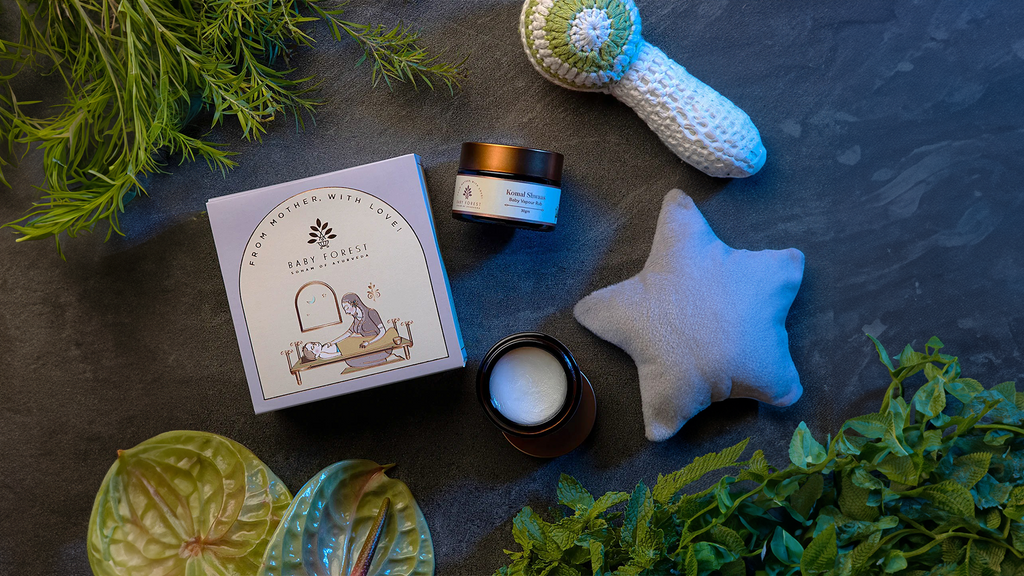
How to Use Baby Vapour Rub for Cough Relief
When your baby has a cough, it can be distressing for both you and your little one. Babies, especially newborns, have delicate immune systems, which means even the smallest cold or cough can leave them feeling uncomfortable. As parents, we're always looking for safe and effective ways to bring relief to our babies, and one popular remedy is using baby vapour rub.
Vapour rubs are known to help ease congestion, clear stuffy noses, and provide relief from coughing. However, knowing how to use them correctly and safely is essential, especially for young infants. In this blog, we'll walk you through the benefits of using vapour rub for babies and share tips on how to use it effectively to provide relief from coughs and colds.
What is a Baby Vapour Rub?
Vapour rub is a soothing ointment that works by releasing comforting vapours from natural oils like eucalyptus and rosemary to help relieve congestion. When your baby is dealing with a stuffy nose or cough, these vapours open up the nasal passages, making it easier for them to breathe. This is especially helpful at bedtime when coughing can get worse, and sleep becomes difficult. Plus, many baby vapour rubs contain calming oils like lavender and thyme, which can help your little one relax and sleep better.
However, it's important to choose a vapour rub that's specifically made for babies. Regular vapour rubs, designed for adults, often have stronger ingredients that might be too harsh for your baby's sensitive skin and respiratory system. Baby vapour rubs are made with gentler, natural ingredients that are safe for your little one, giving them relief without any risks. So, always check the label to ensure it is baby-friendly!
How Does Vapour Rub Work?
When you apply vapour rub to your baby's chest, back, or feet, the warmth from their body helps release the soothing vapours into the air. These vapours are then inhaled, which helps to reduce nasal congestion and ease coughing. Some vapour rubs also contain essential oils that are absorbed through the skin, providing a calming and relaxing effect.
It's a popular remedy because it's non-invasive and doesn't require your baby to ingest anything, making it ideal for babies who are too young for over-the-counter medications. Vapour rub provides an effective way to support your baby's breathing while they're fighting off a cold or cough.
Tips for Using Baby Vapour Rub Safely
While vapour rub is generally safe for babies, it's important to follow a few precautions to make sure your baby gets the most benefit without any risks.
-
Check the age recommendations:
Always check the label to see to it that the vapour rub is suitable for your baby's age. Some products are designed specifically for babies over 3 months, while others may be safe from birth.
-
Do a patch test:
Babies have sensitive skin, so it's a good idea to do a patch test before applying vapour rub all over. Apply a small amount on your baby's forearm and wait for 24 hours to check for any allergic reactions or skin irritation.
-
Avoid applying near the nose or eyes:
Never apply vapour rub directly under your baby's nose or near their eyes, as the strong vapours can irritate these sensitive areas. Instead, focus on the chest, back, and bottoms of their feet.
-
Apply before bedtime:
Vapour rub works best when applied just before bedtime, as it helps to open up airways and provide comfort throughout the night.
How to Use Baby Vapour Rub for Cough Relief
Now that you know how vapour rub works, here's a step-by-step guide on how to use it effectively for your baby's cough relief:
-
Step 1:
Take a small, adequate amount of vapour rub on your fingertips.
-
Step 2:
Gently massage it onto your baby's chest, back, and bottom of their feet. You can also apply a small amount on their forehead.
-
Step 3:
Make sure the area is covered with light clothing to keep your baby warm and allow the vapours to work their magic.
-
Step 4:
For older babies (over 6 months), you can use a warm towel to cover the chest after applying the vapour rub for added comfort.
-
Step 5:
Reapply the vapour rub whenever necessary, especially before naps or bedtime.
Choosing the Right Vapour Rub
When choosing a vapour rub for your baby, it's important to go for a product made with natural, safe ingredients. One such option is the Baby Forest Komal Shwaas Vapour Rub, which is specifically designed for babies. It contains a blend of natural oils, such as eucalyptus oil, lavender oil, and rosemary oil, which are known for their soothing and congestion-relieving properties.
To use Baby Forest Komal Shwaas Vapour Rub, simply take an adequate amount on your fingers and apply it gently to your baby's chest, nose, forehead, and the bottom of their feet. Its gentle, natural ingredients like beeswax, coconut oil, and sesame oil make it perfect for your baby's sensitive skin, while the combination of essential oils helps calm the cough and open up the airways.
What's more, this vapour rub is free from parabens and is Ayush-certified, ensuring it's safe for your little one. The derma-safe formula means it's unlikely to cause irritation, and it provides a natural, non-invasive way to ease cough symptoms in your baby.
Additional Ways to Ease Your Baby's Cough
While vapour rub can be very effective, there are a few additional things you can do to make your baby more comfortable when they have a cough:
-
Use a humidifier:
Adding moisture to the air can help soothe your baby's irritated throat and loosen mucus, making it easier for them to breathe.
-
Elevate your baby's head:
If your baby has a stuffy nose or cough, gently elevate their head with a pillow (for older babies) or place a towel under the mattress for younger infants to help reduce congestion.
-
Offer plenty of fluids:
Keeping your baby hydrated is essential when they're not feeling well. If your baby is breastfeeding or formula-feeding, offer feeds more frequently.
-
Give them a warm bath:
A warm bath can help ease congestion and soothe your baby. The steam from the water helps open up their nasal passages, providing relief.
Conclusion
Using vapour rub is just one of the many ways to comfort your baby during a cough. However, it's important to remember that every baby is different. Some may respond quickly to vapour rub, while others might need additional care such as a humidifier or warm baths. The key is to create a comforting and soothing environment that helps your baby feel relaxed and secure.

How to Avoid Nipple Confusion While Breastfeeding and Bot...
Breastfeeding is a beautiful way to bond with your baby, but it can come with its own set of challenges. One of those challenges is nipple confusion, which can happen when a baby is introduced to both breastfeeding and bottle feeding. Nipple confusion occurs because breastfeeding and bottle feeding require different sucking techniques, and babies may struggle to switch between the two. Sometimes, this leads to babies preferring the bottle, making breastfeeding more difficult.
While nipple confusion can be frustrating, the good news is that there are simple steps you can take to prevent it and help your baby transition smoothly between breastfeeding and bottle feeding. Let's break down what nipple confusion is, why it happens, and what you can do to avoid it.
What is Nipple Confusion?
Nipple confusion occurs when a baby has trouble switching between the breast and a bottle. Breastfeeding requires a baby to latch onto the breast and use their tongue and jaw to draw milk, while bottle feeding involves a different, often easier, sucking motion. If a baby gets used to the quicker and easier milk flow from a bottle, they might reject breastfeeding or struggle with proper latching.
Why Does Nipple Confusion Happen?
Babies are born with natural instincts to breastfeed, but introducing a bottle too early can sometimes interfere with these instincts. Nipple confusion can happen when:
-
The baby is introduced to a bottle too early:
This can happen before the baby has fully learned how to breastfeed.
-
The bottle offers milk more easily than the breast:
Bottles often deliver milk faster with less effort, which can make babies prefer the bottle.
-
Different sucking techniques:
Babies use different muscles and techniques when feeding from a bottle compared to breastfeeding. The bottle requires less coordination and muscle effort.
-
Inconsistent feeding schedules:
Switching between the bottle and breastfeeding inconsistently may confuse the baby, especially if they prefer the easier method.
How to Avoid Nipple Confusion
Here are some tips on how to avoid nipple confusion and create a smooth balance between breastfeeding and bottle feeding.
-
Focus on Breastfeeding First
The best way to prevent nipple confusion is to establish breastfeeding first before introducing a bottle. Experts suggest waiting at least 3-4 weeks after birth to introduce the bottle. This allows the baby to learn how to latch and breastfeed properly.
Make sure you and your baby are comfortable with breastfeeding before you start bottle feeding. Once you feel confident that breastfeeding is going well, you can slowly introduce the bottle.
-
Pick the Right Bottle and Nipple
Choosing the right bottle and nipple can make a big difference. Look for bottles designed to mimic the breast. These bottles have wider, softer nipples that encourage babies to latch in a way that's similar to breastfeeding.
Also, use a slow-flow nipple when bottle feeding. Slow-flow nipples release milk more slowly, which makes the baby work harder to get the milk; just like when they breastfeed. This helps prevent them from preferring the baby feeding bottle because of the faster milk flow.
-
Try Paced Bottle Feeding
Paced bottle feeding is a method that helps mimic breastfeeding by slowing down the feeding process. It can prevent babies from becoming too used to the faster flow of milk from a bottle.
To do this, hold the bottle more horizontally so the milk flows slowly. Let the baby control the pace by taking small breaks during the feeding. This encourages them to use a similar sucking pattern to what they do during breastfeeding, which helps avoid nipple confusion.
-
Keep a Consistent Feeding Routine
Once your baby is comfortable with both breastfeeding and bottle feeding, try to keep a consistent feeding routine. For example, you could breastfeed during the day and give a bottle in the evening or at night. Sticking to a regular schedule can help your baby get used to switching between breast and bottle without any confusion.
Babies love routines, so having a feeding schedule will help them adjust to both methods more easily.
-
Make Bottle Feeding Feel Like Breastfeeding
When you bottle feed your baby, try to make it feel similar to breastfeeding. Hold your baby in the same position you use while nursing and maintain skin-to-skin contact. You can even switch sides halfway through the bottle, just like you would when switching breasts during breastfeeding.
By making bottle feeding feel like breastfeeding, you're helping your baby feel more comfortable with both methods.
-
Avoid Using the Bottle for Comfort
It's easy to reach for the bottle when your baby is fussy but try not to use it as a way to comfort them every time. Instead, offer comfort through breastfeeding, rocking, or cuddling. This way, your baby won't start associating the bottle with comfort and might continue to prefer the breast for feeding.
If your baby gets used to the bottle for comfort, it could make them less interested in breastfeeding, which might lead to nipple confusion.
-
Be Patient and Flexible
It's important to stay patient throughout the process. Even with all the right steps in place, some babies might still struggle with nipple confusion. Don't be discouraged if this happens. It's a learning process for both you and your baby, and with time, things will get easier.
If you notice your baby is struggling, you might need to take a break from the bottle for a few days and focus on breastfeeding. Gradually reintroduce the bottle once your baby feels comfortable again.
Recognizing the Signs of Nipple Confusion
It's essential to recognize the early signs of nipple confusion so you can address it quickly. Here are a few signs to look out for:
-
Difficulty latching:
If your baby suddenly struggles to latch onto the breast after being introduced to a bottle, it could be a sign of nipple confusion.
-
Preference for the bottle:
Some babies may start to refuse the breast and only want to bottle-feed because it's easier.
-
Fussing at the breast:
Babies with nipple confusion may fuss or cry at the breast, showing frustration when they can't get milk as quickly as they do from a bottle.
Conclusion
It is important to trust yourself as a parent. Listen to your baby's cues, adjust your feeding routine as needed, and remember that you're doing a great job. The goal is to nourish your baby in the best way possible, and with time, both breastfeeding and bottle feeding can coexist smoothly, making sure your baby is healthy, happy, and well-fed.

Here Are The Best Ways to Treat Diaper Rashes: Home Remedies
Is your baby fussy and uncomfortable because of those itchy diaper rashes? Moms are always extra careful with their baby's sensitive skin, but even the best diapers might not always prevent rashes. Almost every baby experiences diaper rashes during their first year. The good news is that with the right care and products, you can treat and prevent diaper rashes effectively.
Is It Diaper Rash or a Yeast Infection?
It's important to know whether your baby has a simple diaper rash or a more serious yeast infection, as both require different treatments. So, how do you tell the difference?
- Diaper Rash: If the rash is slightly red, dry, and not oozy or painful, it's most likely a diaper rash. With the right diaper rash treatment, it should clear up in just a couple of days.
- Yeast Infection: If the patches are located in the folds of the skin or groin area and are oozy, bumpy, or bleeding, it might be a yeast infection. In severe cases, your baby may also develop a fever. A yeast infection can take a few weeks to clear and may need prescription medicines.
Understanding this distinction is key to giving your baby the right care, whether it's home remedies or a prescribed solution.
What Causes Diaper Rashes?
There are several common causes of diaper rashes. Understanding these can help you take the right preventive steps.

Skin Reactions
Babies have extremely sensitive skin, and products like detergents, soaps, creams, and even diapers can cause reactions. Many of these products contain chemicals like boric acid, benzocaine, and salicylates, which are harmful to babies and can lead to diaper rashes.
Solution: Always opt for natural, chemical-free products. For instance, Baby Forest's Mridul Poshaak Liquid Detergent, Nirmalya Snan Natural Baby Soap, and Sampoorna Snan Baby Body Wash are gentle on your baby's skin and help prevent irritation.
Dryness
Babies' skin is more prone to dryness, especially with the frequent use of diapers and wipes. Dry skin can become inflamed, leading to severe rashes if not treated properly.
Solution: Keep your baby's skin hydrated by regularly applying a gentle moisturizer, such as Baby Forest's Moh Malai Baby Body Lotion. It helps lock in moisture and keeps their skin soft and smooth.
Antibiotic and Citrus Intake
If your baby is taking antibiotics, either directly or through breast milk, it can upset the balance of good bacteria and lead to diaper rashes. Similarly, citrus fruits or acidic foods like tomato sauce can irritate the skin, especially around the diaper area.
Solution: Avoid giving your baby citrus foods until their skin has healed, and if they're on antibiotics, monitor for any signs of rashes.
Friction and Infection
Tight diapers that rub against the skin can cause irritation, leading to diaper rashes. It's important to ensure the diaper fits properly, leaving enough room for air to circulate.
Solution: Make sure the diaper is spacious enough to allow you to fit your hand between the diaper and your baby's belly. This helps reduce friction and allows the skin to breathe.
Home Remedies for Diaper Rash
While there are many creams and products available, some simple home remedies for diaper rash can also be effective. Here are a few you can try:
- Coconut Oil: It acts as a natural moisturizer and has antibacterial properties, which can help soothe irritated skin.
- Aloe Vera Gel: Applying aloe vera gel to the affected area can relieve itching and promote healing.
- Breast Milk: Some mothers find that applying a little breast milk to the rash can help soothe it due to its natural antibodies.
Remember, if the rash doesn't improve after a few days of trying home remedies, consult your doctor.
Which Cream Is Best for Diaper Rashes?
There are countless creams available, but the best diaper rash cream should heal the skin naturally and protect it from further irritation. Baby Forest's Komal Kawach Rash Healing Cream is an Ayurvedic solution that's ideal for treating red, itchy rashes.
Infused with natural coolants like vetiver and moisturizing ingredients such as aloe vera and vitamin E, it forms a protective shield on the skin, preventing infection. For parents seeking a more natural alternative, this rash healing cream is a great choice.
Final Thoughts
Diaper rashes are common, but with the right diaper rash solution, your baby can be comfortable and rash-free. Whether you're opting for natural remedies, choosing the best diaper rash cream, or being cautious with the products that touch your baby's skin, the goal is the same: to keep your baby happy, healthy, and comfortable.
By understanding the causes and knowing the right treatments, you can help your baby avoid the discomfort of diaper rashes and enjoy the benefits of smooth, healthy skin.
Reference Link: Helpful Tips for Diaper Rash: What You Need to Know

How to Perform an Abhyanga Massage for Babies
Massaging your baby is not just a way to relax and bond; it’s a time-honored tradition that has been passed down through generations in India. Known as Abhyanga, this Ayurvedic practice involves the gentle application of warm oil all over the body. Abhyanga massages offer several benefits, including promoting healthy skin, improving circulation, and helping babies sleep better.
For new parents, performing an Abhyanga massage might feel intimidating at first, but with a little practice and patience, it can become a calming routine that both you and your baby look forward to. In this blog, we’ll walk through how to perform an Abhyanga massage for your baby step by step while also explaining the numerous benefits this practice provides.
What is Abhyanga Massage?
Abhyanga is a form of Ayurvedic massage that involves applying warm oil to the skin in long, gentle strokes. Traditionally, oils like sesame oil, coconut oil, or almond oil are used, each offering its own unique benefits. In babies, Abhyanga helps improve skin texture, promotes better blood flow, and can even soothe a fussy child, helping them to relax and sleep more soundly.
In Ayurveda, it is believed that regular oil massages help in balancing the doshas (Vata, Pitta, and Kapha) in the body, which is important for overall well-being. For babies, it also strengthens the immune system and supports their physical development.
Benefits of Abhyanga Massage for Babies
Before we explain how to give an Abhyanga massage, let’s look at why it’s so beneficial for your baby:
-
Improves Circulation:
The gentle strokes during the massage help boost blood flow, which is essential for healthy growth and development.
-
Promotes Relaxation:
A good massage helps soothe your baby’s nervous system, calming them down and making them feel secure.
-
Aids Digestion:
Massaging the stomach area can help with gas, colic, and constipation.
-
Boosts Immune System:
Regular massages help stimulate the lymphatic system, which in turn strengthens the immune system.
-
Encourages Better Sleep:
The warmth of the oil and the rhythmic movements promote relaxation, which helps babies sleep more soundly.

Choosing the Right Oil for Abhyanga Massage
Selecting the right oil for your baby’s massage is an important step. Some of the most commonly used oils include:
-
Sesame Oil:
This is a classic Ayurvedic oil known for its warming properties. It’s especially good for babies born in colder months as it helps retain body heat.
-
Coconut Oil:
Known for its cooling and moisturizing properties, coconut oil is great for babies born during the summer or those with sensitive skin.
-
Almond Oil:
Almond oil is rich in vitamin E, which nourishes the skin and is suitable for all skin types.
-
Olive Oil:
Often used in many homes, olive oil is light and easily absorbed, making it ideal for regular use.
How to Perform an Abhyanga Massage for Your Baby
Now that you know why Abhyanga is so beneficial, let’s break down the steps of giving your baby a soothing and effective massage.
Step 1: Set Up a Comfortable Space
Find a quiet, warm place in your home where you and your baby can relax. Lay down a soft towel or blanket on a firm surface. Make sure the room is at a comfortable temperature, so your baby doesn’t get too cold.
Step 2: Warm the Oil
Pour a small amount of your abyanga oil into a bowl and gently warm it. You can do this by placing the bowl in hot water for a few minutes. Make sure the oil is comfortably warm, but not too hot, by testing it on the inside of your wrist.
Step 3: Start with the Legs
Begin the massage with your baby’s legs. Using your hands, apply the warm oil and gently stroke downwards from the thigh to the ankle. Use firm but gentle pressure and remember to massage both the front and back of the legs. This helps stimulate circulation and muscle development.
Step 4: Move to the Arms
Next, apply oil to your baby’s arms, starting from the shoulders and working your way down to the wrists. You can also massage their tiny hands by gently opening their palms and pressing lightly on each finger. This not only improves circulation but also enhances sensory development.
Step 5: Massage the Chest and Tummy
With gentle strokes, massage your baby’s chest. You can make small circular motions around the chest area, which can help open up the lungs and improve breathing. When massaging the tummy, use circular motions in a clockwise direction to aid digestion and reduce gas or colic.
Step 6: Back and Spine
Gently turn your baby over onto their tummy and apply oil to the back. Using your hands, move in long strokes from the neck down to the bottom of the spine. This is especially relaxing for your baby and helps with the development of their spinal muscles.
Step 7: Massage the Head and Face
Lastly, apply a small amount of oil to your baby’s scalp and massage gently with your fingertips. This promotes hair growth and calms your baby. For the face, use your fingers to gently stroke from the centre of the forehead outward, down the nose, and across the cheeks.
Step 8: Finish with the Feet
Babies love having their feet massaged! Use your thumbs to press lightly on the soles of your feet in circular motions. This helps improve circulation and stimulates the nerve endings in the feet, promoting overall well-being.
Baby Forest’s Shishu Abhyanga Oils
For parents seeking a natural, safe, and effective oil for their baby’s Abhyanga massage, Baby Forest’s Shishu Abhyanga Oils is a fantastic option. This all-in-one oil combo set is designed to provide the perfect oils for your baby’s body and hair massage needs. The combo includes:
-
Maasoom Malish Baby Body Massage Oil:
A gentle body massage oil that nourishes and hydrates your baby’s skin, perfect for daily use.
-
Nanhi Champi Baby Hair Massage Oil:
This oil promotes healthy hair growth and strengthens the scalp, making it ideal for regular head massages.
-
Badami Sneh Organic Almond Cold Pressed Oil:
Rich in vitamin E, this oil deeply nourishes your baby’s skin, leaving it soft and smooth.
-
Narial Tailam Organic Cold Pressed Coconut Oil:
Known for its cooling and moisturizing properties, this coconut oil is perfect for keeping your baby’s skin hydrated, especially during warmer months.
What makes the Shishu Abhyanga Oils even more special is the addition of a complimentary surprise gift—a delightful toy or a handy travel kit, making the set a complete package for your baby’s care routine.
To use these oils, simply warm a small amount in your hands and apply it gently to your baby’s body or hair, following the steps outlined for an Abhyanga massage. The nourishing blend of natural oils will help relax your baby, improve their skin and hair health, and promote restful sleep, making it an essential part of your baby’s daily care routine.
When Should You Do Abhyanga?
Abhyanga can be done daily, preferably before bath time. Some parents like to do it in the morning, while others prefer a gentle massage before bedtime to help their baby sleep. Whatever time you choose, try to be consistent so your baby begins to recognize the routine and feel secure.
Conclusion
As you incorporate Abhyanga into your baby’s daily routine, you’re not only helping their body grow and develop but also nurturing their sense of security and love. So, take your time, enjoy the process, and know that with each gentle stroke, you’re supporting your baby’s health and happiness.

The Home Stretch: Journaling the Third Trimester of Pregn...
Congratulations! You've reached the final stage of your pregnancy journey – the third trimester. These last few months are a time of significant growth and development for your baby, and also a period of profound changes for you. As you prepare to welcome your little one, let's explore the physical and emotional transformations you might experience during this exciting, yet demanding, phase.
The Ever-Expanding Belly:
Your baby is growing rapidly now and putting on weight. This growth spurt translates to a noticeable increase in your belly size. You might find that your clothes are getting tighter and your center of gravity is shifting, affecting your balance and posture. Embrace these changes – they are a testament to the miracle happening within you!

Weight Gain and Its Importance:
Healthy weight gain is crucial throughout pregnancy, and the third trimester is no exception. While the exact amount varies depending on your pre-pregnancy weight and individual factors, most women gain around 11-16 pounds during this period. This weight gain supports your baby's growth, builds reserves for breastfeeding, and prepares your body for labor and delivery.
Pelvic Transformations:
As your baby descends into your pelvis in preparation for birth, you might experience increased pressure and discomfort in your pelvic region. Your body releases a hormone called relaxin, which softens the ligaments and joints in your pelvis to facilitate labor. This can lead to a waddling gait and occasional aches and pains. Gentle exercises, prenatal yoga, and supportive garments can help alleviate discomfort.
Relaxed Bones, Aches, and Pains:
Relaxin doesn't just affect your pelvis; it acts on your entire body. This can lead to increased joint laxity and a heightened risk of injuries. Be mindful of your movements, avoid high-impact activities, and practice good posture to minimize strain. Warm baths, massages, and stretching can also provide relief from aches and pains.
Nourishing Yourself and Your Baby:
Maintaining a healthy diet has been crucial throughout your pregnancy, and it becomes even more important in the third trimester. Your baby's nutritional needs are at their peak, and your body requires adequate nourishment to support labor and postpartum recovery.
Key Dietary Considerations:
-
Focus on nutrient-dense foods:
Include plenty of fruits, vegetables, whole grains, lean protein, and healthy fats in your diet. -
Iron for energy:
Iron is essential for red blood cell production and oxygen transport. Include iron-rich foods like leafy greens, beans, and fortified cereals. -
Calcium for strong bones:
Calcium is vital for your baby's bone development and your own bone health. Consume dairy products, fortified plant milk, and leafy greens.
Special Considerations for Blood Pressure and Sugar:
-
Blood Pressure:
Monitor your blood pressure regularly and report any significant changes to your healthcare provider. If you have high blood pressure, follow a low-sodium diet and manage stress effectively. -
Blood Sugar:
Gestational diabetes is a type of diabetes that can develop during pregnancy. Follow your doctor's recommendations for managing blood sugar levels through diet, exercise, and medication if needed.
Thyroid and Hyperthyroidism:
-
Thyroid Health:
Thyroid hormones play a crucial role in your baby's growth and development. If you have a thyroid condition, work closely with your doctor to ensure proper management throughout your pregnancy. -
Hyperthyroidism:
An overactive thyroid can lead to complications during pregnancy. If you experience symptoms like rapid heartbeat, weight loss, or anxiety, consult your doctor.
Emotional Well-being:
The third trimester can be an emotional rollercoaster. You might experience a mix of excitement, anticipation, anxiety, and even fear as your due date approaches. Remember that these feelings are normal.
Tips for Emotional Wellness:
-
Practice relaxation techniques:
Engage in activities like meditation, deep breathing exercises, or prenatal yoga to manage stress and anxiety. -
Connect with other expectant mothers:
Join prenatal classes or online forums to share experiences and build a support network. -
Communicate with your partner:
Share your feelings and concerns with your partner and seek their support. -
Prepare for postpartum:
Discuss your expectations and concerns about postpartum life with your partner and healthcare provider.
The Final Countdown:
As you navigate the final weeks of your pregnancy, remember to prioritize self-care, listen to your body, and seek support when needed. This is a time of tremendous transformation, both physically and emotionally. Embrace the journey, stay informed, and trust in your body's incredible ability to bring new life into the world.
Disclaimer: This blog post is intended for informational purposes only and should not be considered medical advice. Always consult with your healthcare provider for personalized guidance and care throughout your pregnancy.
Also Read:
Recognizing the Signs of Labor
How to Prepare for Labor and Delivery
Things to do a week before your due date!

Welcoming Your Baby in the 9th Month
The journey of pregnancy is nothing short of extraordinary. From a tiny cluster of cells to a fully formed little human, the transformation within you has been awe-inspiring. As you enter the ninth month, the final chapter of this incredible story is about to unfold. Your baby is making those last crucial preparations for life outside the womb, and excitement is reaching its peak.
Let's look at what's happening with your little one during this final countdown.
It's a time brimming with a mix of emotions: excitement, anticipation, and perhaps a touch of anxiety as you await the arrival of your little one. Let's explore what's happening in this exciting final stage of fetal development.

Fetal Development in the 9th Month
Size and Weight:
Your little one is now about the size of a watermelon, weighing approximately 6 to 9 pounds and measuring around 18 to 22 inches. While they've grown rapidly throughout your pregnancy, growth might slow down this month as they run out of room in your uterus.
Organ Systems:
By the ninth month, all of your baby's organs are fully developed and functional. Their lungs are mature and ready to take their first breath of air. Their digestive system is practicing for life outside the womb by swallowing amniotic fluid, which will help them pass their first stool (meconium) after birth.
Their liver is busy storing iron, which will be essential for red blood cell production in their early months. And their immune system is getting a boost from antibodies passed from you, providing them with some initial protection against infections.
Brain Development:
The ninth month is a time of incredible brain development for your baby. They are forming millions of neural connections that will enable them to learn, grow, and interact with the world around them. Their senses are also sharpening. They can see and hear, and they're becoming increasingly aware of their surroundings.
Position and Movement:
Most babies will settle into a head-down position in your pelvis during the ninth month, getting ready for birth. You might notice that your baby's movements feel less frequent but stronger as they have less space to move around. While it's normal for movements to decrease somewhat, contact your healthcare provider if you're concerned or notice a significant reduction in fetal activity.
How Your Baby is Preparing for Birth
In addition to the developments mentioned above, your baby is making some specific preparations for their grand entrance into the world:
Gaining Fat:
Your baby is packing on the pounds, gaining a layer of fat that will help them regulate their body temperature after birth. This fat also contributes to their adorable chubby cheeks and rounded appearance.
Storing Nutrients:
Your baby is also storing essential nutrients, such as iron and calcium, which will support their growth and development in the early weeks after birth.
Responding to Stimuli:
Your baby is increasingly responsive to light, sound, and touch. They might turn their head towards a light source or react to loud noises. You might even notice them responding to your voice or the touch of your hand on your belly.
Practicing Breathing:
Your baby is practicing breathing movements by inhaling and exhaling amniotic fluid. These practice sessions help prepare their lungs for breathing air after birth.
Developing Sleep-Wake Cycles:
Your baby is developing sleep-wake cycles, although they may not be entirely regular yet. You might notice periods of activity followed by periods of rest.
Conclusion
The ninth month of pregnancy marks the culmination of an incredible journey of growth and development for your baby. They are now well-prepared to enter the world and embark on the next stage of their life. As you cherish these final weeks of pregnancy, take time to rest, connect with your baby, and prepare for the exciting adventure of parenthood.
Remember, every pregnancy is unique, and your baby's development might vary slightly from the average. If you have any concerns about your baby's development or your pregnancy, don't hesitate to talk to your healthcare provider. They are there to support you and ensure a safe and healthy delivery for both you and your baby.
We wish you all the best as you welcome your little one into the world!
Note: This blog post is intended for informational purposes only and should not be considered a substitute for professional medical advice. Always consult your healthcare provider for any concerns regarding your pregnancy or baby's development.
Also Read:
Recognizing the Signs of Labor
How to Prepare for Labor and Delivery

Do’s & Don'ts in the Third Trimester of your pregnancy jo...
The third trimester is the final stretch of your pregnancy journey, a time of anticipation and preparation as you await your little one's arrival. While excitement builds, it's crucial to prioritize your health and well-being during these last few months. Here's a guide to navigating the third trimester, highlighting the essential do's and don'ts to ensure a smooth and healthy finish line.

Third Trimester Do's:
-
Prioritize Protein:
Your baby's growth is at its peak in the third trimester, making protein intake crucial. Include lean protein sources like poultry, fish, beans, lentils, and dairy in your daily diet. Aim for around 75-100 grams of protein per day. This supports your baby's development and helps your body prepare for labor and postpartum recovery. -
Monitor Your Sugar:
Gestational diabetes is a concern during pregnancy. Keep your blood sugar in check by opting for complex carbohydrates like whole grains, fruits, and vegetables over simple sugars. Regularly monitor your blood sugar levels as advised by your doctor and follow any dietary recommendations or medication prescribed. -
Keep a Close Eye on Blood Pressure:
High blood pressure can pose risks during pregnancy. Monitor your blood pressure regularly and report any significant changes to your healthcare provider. Reduce sodium intake, manage stress, and engage in relaxation techniques to keep your blood pressure within a healthy range. -
Breathe Deeply:
Practice breathing exercises regularly. Deep, controlled breathing can help manage shortness of breath, a common complaint in the third trimester as your growing uterus puts pressure on your diaphragm. These exercises also serve as valuable preparation for labor, helping you manage contractions effectively. -
Stay Active with Light Exercise:
Maintain a moderate exercise routine with your doctor's approval. Walking, swimming, and prenatal yoga are excellent options. Exercise improves circulation, strengthens muscles, and boosts your mood. However, avoid high-impact activities and listen to your body, resting when needed. -
Strengthen Your Pelvic Floor:
Kegel exercises are essential for strengthening your pelvic floor muscles, which support your bladder, uterus, and rectum. These muscles can weaken during pregnancy and childbirth. Regular Kegel exercises can help prevent incontinence, improve bladder control, and aid in postpartum recovery.
Third Trimester Don'ts:
-
Don't Neglect Hydration:
Dehydration can lead to complications like preterm labor. Drink plenty of water throughout the day. Carry a water bottle with you as a reminder. Proper hydration also helps prevent constipation, a common issue during pregnancy. -
Don't Overdo It:
While exercise is beneficial, avoid overexertion. Listen to your body and rest when needed. Avoid activities that put excessive strain on your joints and ligaments, which are more relaxed during pregnancy due to hormonal changes. -
Don't Skip Meals:
Maintain regular mealtimes to avoid blood sugar fluctuations and energy dips. Carry healthy snacks like fruits, nuts, or yogurt to curb hunger between meals. Nourishing your body consistently is vital for both your health and your baby's development. -
Don't Ignore Warning Signs:
Be vigilant about any unusual symptoms like vaginal bleeding, severe headaches, sudden swelling, or decreased fetal movement. Report any concerns to your healthcare provider immediately. Prompt medical attention can help prevent potential complications. -
Don't Stress:
Stress can negatively impact your pregnancy. Practice relaxation techniques like meditation, prenatal yoga, or spending time in nature. Engage in activities you enjoy and connect with your support system to manage stress effectively. -
Don't Forget Self-Care:
Prioritize self-care during this demanding time. Get adequate sleep, enjoy relaxing baths, and indulge in activities that bring you joy. Taking care of your emotional and mental well-being is just as important as physical health.
Additional Tips for a Smooth Third Trimester:
-
Attend prenatal classes:
These classes provide valuable information about labor, delivery, and newborn care, helping you feel more prepared and confident. -
Prepare your hospital bag:
Pack essentials for yourself and your baby well in advance to avoid last-minute stress. -
Finalize childcare arrangements:
If you plan to return to work or need childcare assistance, make necessary arrangements ahead of time. -
Communicate with your partner:
Discuss your expectations, concerns, and birth preferences with your partner to ensure you're both on the same page.
The third trimester is a transformative period, filled with both excitement and challenges. By following these do's and don'ts, prioritizing your health, and seeking support when needed, you can navigate this final stage with confidence and embrace the joyous arrival of your little one.
Disclaimer: This blog post is intended for informational purposes only and should not be considered medical advice. Always consult with your healthcare provider for personalized guidance and care throughout your pregnancy.
Also Read:
Recognizing the Signs of Labor
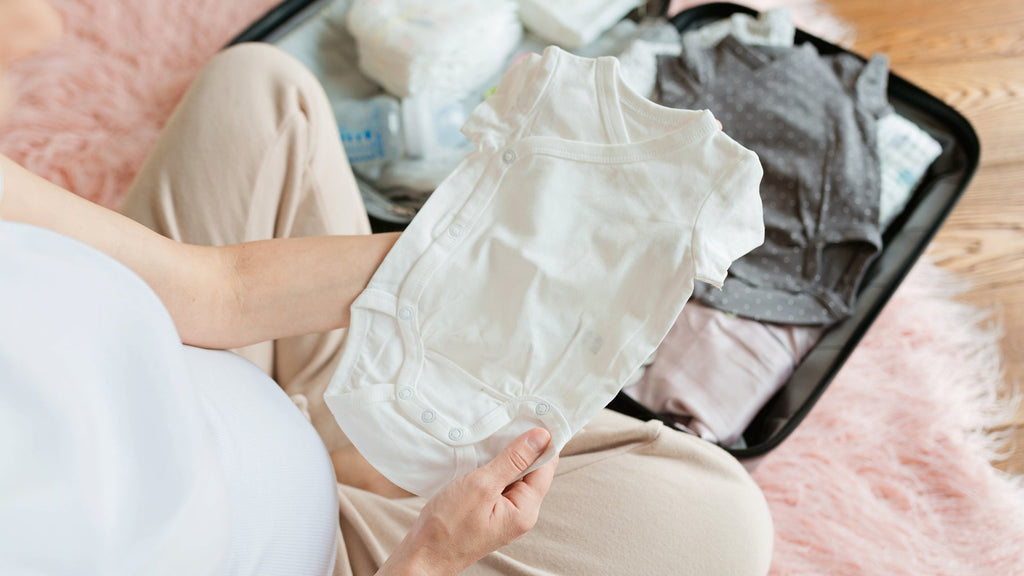
Things to do a week before your due date!
The end of your pregnancy journey is in sight! With just a week to go until your due date, excitement (and maybe a little anxiety) is likely reaching peak levels. While you might feel like nesting instincts are taking over, it's important to use this final week wisely to prepare for labor, delivery, and welcoming your little one. Here's a checklist to help you navigate these last few days:
-
Tie up loose ends:
-
Finalize your birth plan:
Review your birth plan with your doctor or midwife and discuss any last-minute questions or concerns. Ensure your birth partner is also familiar with your preferences. -
Confirm hospital arrangements:
Call your hospital or birthing center to confirm admission procedures, what to bring, and any specific guidelines they have in place. -
Arrange for childcare and pet care:
If you have other children or pets, make sure you have reliable childcare arrangements in place for when you go into labor. -
Prepare for postpartum help:
Line up support for the initial weeks after the baby arrives. This could include family, friends, or a postpartum doula to help with meals, errands, and household chores.
-
Pack your hospital bag (and your partner's too!):
-
For you:
Comfortable clothes, nursing bras, toiletries, phone charger, snacks, entertainment (books, magazines), and any comfort items like a pillow or blanket. -
For baby:
Onesies, sleepers, a going-home outfit, hats, mittens, diapers, and a receiving blanket. -
For your partner:
Snacks, drinks, a change of clothes, toiletries, phone charger, and something to keep them occupied during labor. -
Important documents:
Don't forget your insurance card, identification, and any hospital paperwork.
-
Prepare your home nest:
-
Wash baby's clothes and bedding:
Make sure all of your baby's clothes and bedding are washed and ready to use. Opt for gentle, fragrance-free detergents. -
Set up the nursery:
Ensure the crib is assembled, the changing table is stocked, and you have a designated area for feeding and soothing your baby. -
Stock up on essentials:
Make sure you have plenty of diapers, wipes, formula (if not breastfeeding), and other baby care essentials on hand. -
Cook and freeze meals:
Prepare some freezer meals for the first few weeks postpartum to make mealtimes easier.
-
Pamper yourself and relax:
-
Enjoy a prenatal massage:
A massage can help relieve tension and promote relaxation. -
Get a manicure or pedicure:
Treat yourself to some pampering before your little one arrives. -
Spend quality time with your partner:
Go on a date, watch a movie, or simply relax together and enjoy these last few moments as a couple. -
Catch up on sleep:
Rest as much as possible to prepare for labor and the sleepless nights ahead.
-
Connect with your baby:
-
Talk to your baby:
Spend time talking, singing, or reading to your baby. -
Practice relaxation techniques:
Deep breathing, meditation, and prenatal yoga can help you stay calm and focused during labor. -
Visualize a positive birth experience:
Imagine yourself going through labor and delivery with strength and confidence.
-
Stay informed and prepared:
-
Learn about labor signs:
Familiarize yourself with the signs of labor, such as contractions and water breaking. -
Know when to call your doctor:
Discuss with your healthcare provider when it's time to head to the hospital or birthing center. -
Prepare for the unexpected:
While you may have a birth plan, be prepared for things to potentially deviate. Stay flexible and trust your healthcare team.
-
Embrace the final moments:
-
Reflect on your pregnancy journey:
Take some time to appreciate the incredible changes your body has gone through and the miracle of growing a new life. -
Connect with loved ones:
Spend time with family and friends who will offer support and encouragement. -
Savor these last moments of quiet:
Enjoy the peace before your life is filled with the joys (and challenges) of parenthood.
This final week before your due date is a special time. Use it to prepare practically, emotionally, and mentally for the incredible journey ahead. Soon, you'll be holding your little one in your arms, and all the preparation will be worth it!
Also read:
How to Prepare for Labor and Delivery

How to Prepare for Labor and Delivery
This blog offers a comprehensive approach to preparing for labor, covering physical, mental, and emotional readiness.
Here’s How to Prepare for Labor and Delivery
Labor and delivery are arguably the most anticipated and perhaps daunting aspects of pregnancy. While the process is natural, knowing what to expect and how to prepare can empower you to approach this significant life event with greater confidence and calm.
-
Physical Preparation: Nurturing Your Body
-
Stay Active:
Maintaining a moderate exercise routine throughout your pregnancy, as approved by your healthcare provider, can improve your stamina and muscle tone, which are crucial for labor. Consider activities like walking, swimming, prenatal yoga, or Pilates. -
Kegel Exercises:
Regularly performing Kegel exercises strengthens your pelvic floor muscles, aiding in labor and postpartum recovery. -
Perineal Massage:
From around 34 weeks, gently massaging the perineum (the area between the vagina and anus) can increase its elasticity and reduce the risk of tearing during childbirth. -
Optimal Nutrition:
A balanced diet rich in fruits, vegetables, whole grains, and lean protein provides the energy and nutrients you need for labor and delivery. Stay hydrated by drinking plenty of water. -
Childbirth Education Classes:
These classes offer valuable information about the stages of labor, pain management techniques, and what to expect during delivery. They also provide a safe space to ask questions and connect with other expectant parents. -
Practice Labor Positions:
Experiment with different labor positions, such as squatting, kneeling, or using a birthing ball, to find what feels most comfortable for you. -
Pack Your Hospital Bag:
Prepare a bag with essentials for yourself (comfortable clothes, toiletries, snacks) and your baby (onesies, diapers, blankets).

-
Mental Preparation: Cultivating a Positive Mindset
-
Develop a Birth Plan:
While it's essential to be flexible, a birth plan outlines your preferences for pain management, labor interventions, and postpartum care. Discuss your plan with your healthcare provider and ensure your birth partner is aware of your wishes. -
Educate Yourself:
Read books, watch videos, and attend classes to learn about the labor process. Understanding the stages of labor and potential complications can help alleviate anxiety and empower you to make informed decisions. -
Practice Relaxation Techniques:
Mastering relaxation techniques like deep breathing, meditation, and visualization can help you manage pain and stay calm during labor. -
Address Fears and Concerns:
If you have any fears or anxieties about labor and delivery, discuss them with your healthcare provider, a therapist, or a trusted friend or family member. -
Visualize a Positive Birth Experience:
Imagine yourself going through labor with strength and confidence. Focus on the positive aspects of meeting your baby.
-
Emotional Preparation: Embracing the Journey
-
Connect with Your Partner:
Open communication with your partner about your fears, hopes, and expectations is crucial. Discuss how they can best support you during labor and delivery. -
Build Your Support System:
Surround yourself with supportive family and friends who can offer encouragement and practical help before, during, and after childbirth. -
Nurture Your Emotional Well-being:
Prioritize self-care activities that bring you joy and relaxation, such as reading, listening to music, spending time in nature, or taking a warm bath. -
Prepare for the Postpartum Period:
While focusing on labor is essential, consider preparing for the postpartum period by lining up support for breastfeeding, childcare, and household chores.
-
The Final Weeks: Fine-tuning Your Preparations
-
Rest and Recharge:
In the final weeks leading up to your due date, prioritize rest. Your body is working hard to prepare for labor, so listen to its cues and slow down. -
Stay Hydrated and Nourished:
Continue to eat a healthy diet and drink plenty of water to maintain your energy levels. -
Connect with Your Baby:
Spend time talking, singing, or reading to your baby. This bonding experience can help you feel more connected and prepared for parenthood. -
Finalize Arrangements:
Confirm childcare arrangements, pack your hospital bag, and finalize any outstanding tasks or errands. -
Trust Your Body and Your Instincts:
Remember that your body is designed to give birth. Trust in its ability and your instincts during labor.
Labor and delivery are unique experiences for every woman. By preparing physically, mentally, and emotionally, you can approach this transformative event with confidence and embrace the incredible journey of bringing your baby into the world. Remember to stay flexible, communicate openly with your healthcare team and support system, and trust in your body's innate ability to birth your child.
Also read:
Recognizing the Signs of Labor
10 Healthy Snacks for Pregnant Women

The Countdown Begins: Recognizing the Signs of Labor
Pregnancy is a journey full of anticipation, excitement, and, let's face it, apprehension as you approach your due date. As the final weeks arrive, you'll likely find yourself eagerly awaiting the signs that your little one is ready to make their grand entrance. While every pregnancy and labor experience is unique, some common signs signal your body is preparing for birth. Understanding these signs can help you feel more informed, empowered, and ready to welcome your baby into the world.
Early Signs: Your Body's Subtle Hints
Even before active labor begins, your body makes subtle shifts in preparation for birth. These early signs can appear weeks or even just days before labor:
-
Lightening or "Dropping":
As your baby descends further into your pelvis, you may notice a change in your belly's shape. You might feel less pressure on your diaphragm, making breathing easier, but increased pressure on your bladder, leading to more frequent bathroom trips. -
Increased Vaginal Discharge:
You might observe an increase in vaginal discharge, which can be clear, pink, or slightly bloody. This indicates that the cervix is starting to soften and dilate. -
Cervical Changes:
Your cervix, the opening to your uterus, begins to soften, thin (efface), and open (dilate) in preparation for labor. This process can start weeks before labor or happen quite rapidly. -
Nesting Instinct:
A sudden burst of energy and an overwhelming urge to clean and organize everything in sight? This "nesting instinct" is a common sign that your body is gearing up for labor. -
Braxton Hicks Contractions:
These "practice contractions" are irregular, usually painless tightenings of your uterus. They can start early in pregnancy but might become more noticeable as you approach your due date. Unlike true labor contractions, they don't increase in intensity or frequency. -
Loose Joints and Backache:
Hormonal changes can loosen the ligaments in your body, particularly in your pelvis, leading to increased backache and instability in your joints.

Active Labor is Approaching: The Main Event
While the early signs offer clues, the following signs typically indicate that active labor is imminent:
-
Strong, Regular Contractions:
The hallmark of true labor is the presence of strong, regular contractions that increase in intensity, frequency, and duration. These contractions feel like a tightening or cramping sensation in your abdomen and lower back. Unlike Braxton Hicks contractions, they don't go away with rest or a change in position. -
Water Breaking:
The amniotic sac, which surrounds your baby, can rupture before or during labor. This is often described as a gush or a trickle of fluid from your vagina. If your water breaks, contact your healthcare provider, as labor is likely to follow soon.
Also read: Hospital Bag Checklist for Delivery 2024
When to Call Your Healthcare Provider
If you experience any of the following, it's important to contact your healthcare provider immediately:
- Regular, painful contractions that are five minutes apart, lasting for one minute, and continuing for an hour.
- Vaginal bleeding.
- A decrease in your baby's movements.
- Your water breaks, especially if the fluid is green or brown.
- Severe headaches or vision changes.
Labor is a powerful and unique experience. By understanding the signs and preparing yourself both physically and emotionally, you can approach this momentous occasion with confidence and anticipation. Remember, your healthcare provider is your best resource for any questions or concerns you may have. Trust your body, listen to your instincts, and embrace the incredible journey of bringing your baby into the world.
Also read:
Prenatal Yoga and Its Benefits for Pregnant Women

Common Skin Conditions in Babies: An Expert Guide for Par...

Is Formula Feeding Safe for Your Little One?
As a new parent, one of the biggest decisions you'll make is how to feed your baby. Everyone seems to have opinions about breastfeeding vs. formula, and it can feel overwhelming. Maybe you've been trying to breastfeed, but it's been tough, or life's busy schedule is making it harder to stick with it.
No matter the reason, you just want to be sure your baby is getting the right nutrition. That's where formula feeding comes in. It's a great option that many parents rely on to keep their baby healthy and well-fed, even if breastfeeding isn't working out. But you might still be wondering, "Is formula feeding good for newborns?” Let’s walk through what formula feeding is, how it works, and why it could be a good choice for you and your baby.
What Is Formula Milk?
Formula milk is a specially made option for feeding babies when breastfeeding isn't possible or preferred. It's created in clean, safe conditions and is designed to be as close to breast milk as possible, with added vitamins and minerals that help babies grow. While it does not have the natural antibodies found in breast milk, formula milk for newborns still gives babies the nutrients they need for healthy development.
There are different types of formulas available, and it might feel a bit overwhelming at first to choose the right one. But don’t worry—you will find what works best for your baby. Preparing formula is simple, just mix it with the right amount of clean water and make sure the bottles and nipples are properly sterilized.
Formula Feeding Chart: How Much to Feed Your Baby
When starting with formula feeding, it's important to follow a formula feeding chart to ensure your baby is getting the right amount of nutrition. Newborns usually need about 2 to 3 ounces of formula every 2 to 3 hours. As your baby grows, their needs will increase, and the feeding chart will adjust accordingly. Tracking how much your baby consumes is easier with formula feeding, as you can measure the exact amount in each bottle.
Breastfeeding vs. Formula: Understanding the Differences
Many parents wonder about the differences between breastfeeding vs. formula feeding. While both methods provide essential nutrition, each has its own set of benefits:
-
Breastfeeding:
It gives your baby natural antibodies that help protect them from infections. Plus, it’s a great way for moms and babies to bond. However, some moms may struggle with things like low milk supply or issues with latching.
-
Formula Feeding:
It’s more flexible because anyone can help with feeding, and you can easily measure how much your baby is drinking. It also lets moms share the feeding duties with family members, giving them a much-needed break.
In the end, choosing between breastfeeding and formula is a personal choice, and many families find that a mix of both works best for them.
Related Read: Is Formula Feeding Safe For Your Lil One?
Is Formula Feeding Good for Newborns?
Yes, formula feeding is good for newborns, especially if breastfeeding is not an option due to medical conditions, lifestyle challenges, or other factors. Formula milk is designed to closely replicate the nutritional profile of breast milk, ensuring that your baby gets essential vitamins, minerals, and proteins for growth.
In some cases, such as with premature babies or those with health concerns like low blood sugar or jaundice, formula feeding can be particularly beneficial as it helps them recover quickly and build strength.
Benefits and Considerations of Formula Feeding
While formula feeding is a great option for many parents, there are some pros and cons to keep in mind.
Benefits of Formula Feeding:
-
Flexibility:
Anyone can feed the baby with formula, so if the mother is unavailable, someone else can step in. This gives fathers and other family members a chance to bond during feedings.
-
Tracking Feeds:
Formula feeding allows you to measure exactly how much your baby is eating, which is helpful for ensuring they're getting the right amount of food according to their age.
-
Nighttime Convenience:
Formula feeding can make nighttime easier, especially if parents take turns with feeding. Moms can get sleep as soon as possible while others take over.
-
Nutrient-Rich Alternative:
Formula is packed with nutrients that aren't beneficial, especially for babies who might need extra support, like those born prematurely.
-
Freedom for Moms:
Formula-feeding moms have more freedom in their diet since they don't have to worry about passing certain foods through breast milk. It's also helpful for moms who can't produce enough milk.
Considerations:
-
Lack of Antibodies:
Formula does not contain the natural antibodies that help boost the baby's immune system, which are found in breast milk.
-
Cost:
Formula feeding can be more expensive compared to breastfeeding.
-
Preparation:
Formula needs to be prepared with clean water and sterilized bottles, which requires time and effort.
Choosing the Right Formula and Feeding Bottle
Finding the right formula and baby feeding bottle is key to a smooth formula-feeding experience. There are different types of formula, like cow's milk-based, soy-based, or hypoallergenic options. It’s always a good idea to talk to your pediatrician to figure out which formula is best for your baby.
Choosing the right bottle is just as important. For example, Baby Forest’s Laad Pyaar Feeding Bottle is easy to clean and can be safely used with sterilizers. It also has a comfortable grip that’s perfect for little hands, making it easier for babies to start learning how to hold the bottle themselves.

10 Healthy Snacks for Pregnant Women
Pregnancy is such a special time, but it also means your body needs a little extra care and nourishment—not just for you, but for your growing baby. If you're finding yourself reaching for snacks more often, don't worry, that's totally normal! Your body is working hard, and it's natural to crave more frequent bites throughout the day.
But here's the thing; snacking during pregnancy doesn't have to be dull or unhealthy. In fact, there are plenty of tasty options that can keep you satisfied and give you the nutrients both you and your baby need. So, let's talk about 10 healthy snacks for pregnant women that are super easy to make and will keep your energy levels up all day long.

-
Fresh Fruits with Yogurt
-
Roasted Makhana (Fox Nuts)
-
Boiled Eggs
-
Nuts and Dry Fruits
-
Vegetable Sticks with Hummus
-
Sprout Salad
-
Oats with Milk and Fruits
-
Khakra with Peanut Butter
-
Sweet Potato Chaat
-
Coconut Water with Fresh Fruit
Related Read - What to Eat When Pregnant: Your Ultimate Guide to a Healthy Pregnancy Diet
Conclusion
During pregnancy, your body is constantly changing, and it's important to fuel it with snacks that nourish both you and your baby. Snacking isn't just about satisfying your cravings, it's a great chance to choose foods that keep your energy up, make you feel good, and help your baby grow strong and healthy.
The secret to healthy snacking during pregnancy is variety. By mixing up your snacks with wholesome options like fruits, veggies, nuts, whole grains, and dairy, you can keep your energy levels steady and avoid reaching for unhealthy options. Listening to your body's hunger signals and choosing nutrient-rich foods not only benefits you now but also sets the foundation for healthy eating habits in your family.

An Ideal Hair Care For Babies- What You Must Know?
New parenting is a roller coaster ride of emotions and learning. Among the various concerns parents have, baby hair care often tops the list, especially when something seems unusual. Whether it's shedding hair or dealing with cradle cap patches, parents can feel unsure and worried. However, there’s no need to panic—these are common and manageable concerns. Here, we have put together some essential tips, facts, and must-haves for the ideal baby hair care routine for your tiny tots.
Is Your Newborn's Hair Normal?
When it comes to newborns, there is no single standard for what “normal” hair is. A baby might be born with feathery hair, thick locks, or even no hair at all. The good news is, all of it is completely normal. Babies with thick lanugo (the hair present before birth) may shed their hair later, while bald babies will grow their vellus hair (the fine hair that appears after lanugo sheds). Even babies with thin hair may experience shedding or texture changes. These variations are due to hormones and genetics inherited from the mother during pregnancy. As newborns grow and adjust to the world, their hair changes in color, texture, and thickness over time.
Benefits of Bathing Baby Daily for Healthy Hair
Many parents wonder if they should bathe their babies daily, especially when it comes to baby hair care. The benefits of bathing a baby daily extend beyond cleanliness; regular baths help keep the scalp healthy and free from oils and dirt that could clog hair follicles. Additionally, daily bathing at a fixed time helps regulate your baby’s body, improving hair growth by maintaining a healthy scalp environment. However, it's important to use gentle products that won’t dry out the baby's sensitive skin and scalp.
Hair Routine: Less is More
A baby's hair is five times more delicate than an adult’s, which means that hair care routines need to be gentle. Keeping the scalp clean and healthy is key for strong and healthy hair growth. But remember, for babies, less is more—fewer products, natural and organic baby products, gentle care, and avoiding excessive washing are essential.
Essential Steps for an Ideal Baby Hair Care
-
Oil Massage for Baby’s Scalp
One of the most delicate parts of a baby’s body is their scalp, which requires proper nourishment to stay healthy. Regular oil massages are excellent for moisturizing the scalp, preventing dandruff, and making it easier to detangle knots that may form due to your baby rolling their head around.
Massage also helps remove cradle cap flakes. The added benefit? Massaging your baby’s scalp improves blood circulation, which helps stimulate hair growth and also makes your baby feel relaxed and ready for a good nap afterward. For the best results, use oils that are soft, enriching, and free of added fragrances. Baby hair oil with coconut oil, olive oil, and sesame oil are excellent options for baby hair care.
For instance, the Baby Forest’s Nanhi Champi Baby Hair Oil is a derma-safe, cruelty-free, and vegan oil, enriched with Ayurveda's goodness. It contains coconut, sesame, and other natural oils that nourish your baby’s scalp.
How to Bathe a Newborn for Healthy Hair
Understanding the correct baby bath procedure is important for maintaining healthy hair. Here’s a step-by-step guide for washing your baby’s hair during bath time:

Prepare the bath:
Firstly, make sure you have everything you need around you - shampoo, towel, cup, and washcloth—before you start to avoid leaving your baby unattended.
Check the water temperature:
The ideal temperature is around 98°F. You can test it by dipping your wrist in the water.
Gently wet the baby’s scalp:
Use a small cup or your hand to carefully wet their hair.
Apply a small amount of baby shampoo:
Opt for a gentle, chemical-free shampoo, like Baby Forest’s Nikhrae Kesh Baby Shampoo, which is formulated to cleanse without stripping away natural oils.
Rinse thoroughly:
Using a cup, gently pour water to rinse off all the shampoo.
Dry the hair gently:
Pat your baby’s head with a soft towel to dry their hair without causing friction.
Baby Hair Products to Use
Choosing the right baby hair care products is crucial for your child’s scalp health. Here are some must-haves for your baby’s hair care routine:
-
Baby Oil:
Helps moisturize the scalp and untangle hair.
-
Gentle Baby Shampoo:
Opt for a chemical-free shampoo that’s safe for babies.
-
Soft Towels:
Use soft, absorbent hooded towels to dry your baby’s hair after a bath.
Combing - A Key to Healthy Hair
Many people are unaware of how important the right comb is for baby hair care. Combing helps open up the pores on the scalp and promotes natural oil (sebum) production. This not only moisturizes the scalp but also stimulates healthy hair growth. Avoid using ordinary combs, as they may cause irritation or scratch your baby’s scalp.
For the best results, use Baby Forest’s Sunhere Resham comb, which is made from natural sources and is gentle enough for newborns and toddlers. It’s designed to make combing a relaxing experience for your baby, while ensuring their scalp is well cared for.
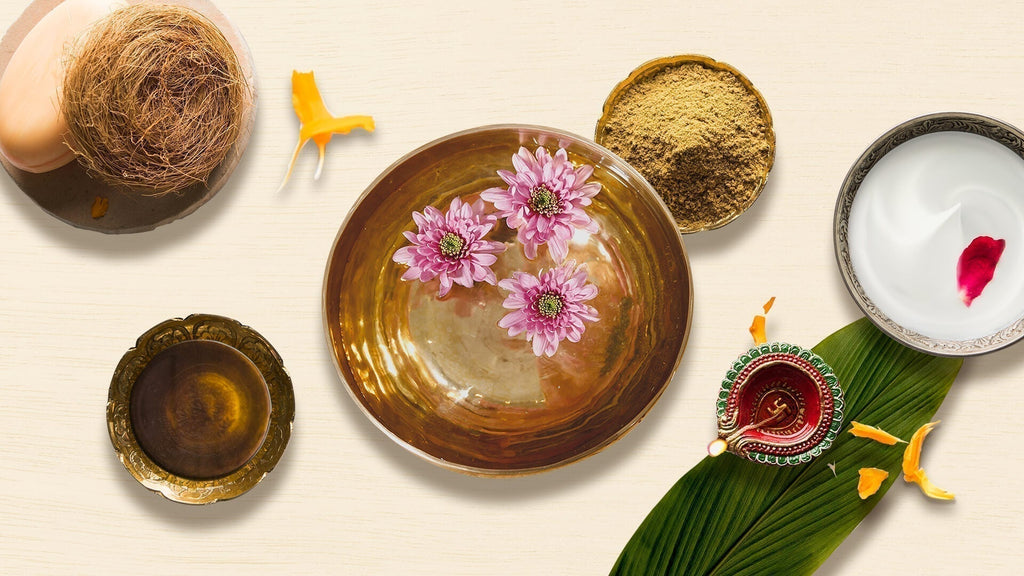
Baby Bath Ritual: An Essential Ritual for Baby’s Growth &...
Baby bath rituals in India are deeply rooted in the ancient holistic wellness concepts of Ayurveda and are intrinsic to mother and childcare. According to Ayurveda, bathing is a therapeutic, healing experience that restores physical energy, removes accumulated toxins, sweat, and dirt from the baby’s skin, and relaxes the mind by balancing emotions. While it may seem like a simple task, a baby bath ritual is packed with benefits that go beyond just cleanliness.
A baby’s first bath is considered one of the most nourishing, cleansing, and comforting experiences in their early life.
Benefits of Bathing a Baby Daily
Many parents wonder whether they should bathe their baby every day. The benefits of bathing a baby daily is numerous and go far beyond maintaining hygiene. Daily baths, especially at a fixed time, help relax the baby, restore their balance, and promote natural growth. Establishing this routine can make the baby feel more secure and comfortable.
-
Calms and Relaxes
Bathing has a calming effect on babies, which can help them sleep better, particularly if included as part of their bedtime routine.
-
Cleanses Skin Gently:
Daily bathing helps remove dirt, sweat, and accumulated oils, ensuring your baby’s skin stays fresh and healthy.
-
Promotes Circulation:
Bathing improves blood circulation, which helps the baby's muscles relax, fostering overall physical development.
How to Bathe a Newborn: A Step-by-Step Guide
Understanding the proper baby bath procedure is essential for new parents. Bathing a newborn may seem overwhelming, but following these steps can make the experience smooth and enjoyable.

Step 1: Warm Oil Massage Before Bath Time
According to Ayurveda, a warm oil body massage is essential for the baby as it controls aggravated Vata Dosha, emphasizing the belief that touch therapy creates a beautiful, deep bond between the mother and child. Before the bath, use gentle oils to massage the baby’s body, helping soothe their muscles and prepare them for the bath.
Baby Forest has formulated the Maasoom Maalish baby body massage oil with a blend of 10 Ayurvedic essential oils. These oils, derived from herbs, flowers, and medicinal plants, strengthen the baby’s blood vessels, improve blood circulation, and help in bone development.
Step 2: Gentle Cleanse During the Bath
According to Ayurvedic philosophy, a bath helps in eliminating stress, cleansing the skin, and soothing the nerves.
To ensure a gentle cleanse, use Baby Forest’s luxurious Sampoorna Snan Baby Body Wash. This product, enriched with Ayurvedic herbs and oils, keeps your baby’s delicate skin hydrated, maintains its natural moisture, and leaves it soft and supple.
Step 3: Deep Moisturizing After Bath
After a refreshing bath, it’s crucial to lock in moisture to prevent your baby’s skin from drying out. Apply the Moh Malai Baby body lotion, a lightweight, deeply hydrating cream enriched with Shea butter, Rose Petals, and Mulethi. It penetrates deeply into the skin, ensuring intense moisturization and nourishment.
Must Have Baby Hair Care Products
Many parents overlook the importance of caring for their baby’s hair. Just like skin, a baby’s hair requires gentle care and attention. Baby hair products that are mild and formulated for sensitive skin are crucial to ensure that the baby’s scalp stays clean and healthy.
-
Shampooing:
Use a mild baby shampoo that’s free from harsh chemicals. A gentle formula cleanses without stripping away the natural oils, keeping the scalp healthy.
-
Hair Oil:
For babies with a dry scalp, applying a small amount of baby hair oil can help keep their hair soft and manageable.
Baby Forest offers specially formulated baby hair care products that are gentle on the baby’s scalp and keep their hair healthy and shiny.

Creating a Soothing Bath Time Routine
The key to a successful baby bath procedure is making sure the environment is calm, and the baby feels secure. Here’s how to make the process even more soothing for your baby:
-
Use Soothing Music or Lullabies:
Playing soft music or singing to your baby during bath time can create a comforting atmosphere.
-
Introduce Bath Toys:
For older babies, adding toys to bath time can make the experience more engaging and fun.
-
Maintain Eye Contact and Smile:
A reassuring smile and gentle eye contact help your baby feel safe and loved during the bath.
Baby Bath Essentials: What You Need
Having the right products makes all the difference in ensuring a smooth, safe, and enjoyable bath time. Here’s a quick look at the must-have baby bath essentials:
|
Bath Essential |
Why You Need It |
|
Mild Baby Soap |
Gentle on your baby’s sensitive skin, cleanses without irritation. |
|
Soft Washcloth |
Perfect for cleaning those tiny folds and creases. |
|
Baby Bathtub |
Provides a safe, secure space for the baby to bathe. |
|
Hooded Baby Towel |
Keeps your baby cozy and warm right after the bath. |
|
Moisturizing Lotion |
Helps lock in moisture, protecting delicate skin from dryness. |
|
Water Thermometer |
Ensures the bathwater is at a safe, comfortable temperature. |
Conclusion
Incorporating a daily bath routine for your baby is not just about maintaining hygiene but also about promoting overall growth and wellness. With the right baby bath products, a gentle bath procedure, and some love and care, you’re ensuring that your baby enjoys both the physical and emotional benefits of this calming ritual.
Make bath time a bonding moment that relaxes your baby, supports their growth, and keeps them happy and healthy!

Travel During Pregnancy: Dos and Don'ts for a Stress-Free...
Pregnancy comes with its fair share of excitement, but let's be real—it also comes with a lot of changes. From growing bellies to unexpected cravings, your body is constantly reminding you that you're on a pretty amazing journey. But does that mean you have to hit pause on your travel plans? Not at all! Whether it's a family visit, a much-needed vacation, or even a work trip, many moms-to-be find ways to travel during pregnancy.
Of course, travelling while pregnant does take a little extra planning and care. Your body has different needs now, and it's all about balancing your adventure with comfort and safety. So, whether you're catching a flight or hitting the road, knowing a few dos and don'ts can make the whole experience a lot smoother.
Here's how you can enjoy your trip while taking care of yourself and your growing baby.
Dos for Traveling During Pregnancy
Consult Your Doctor Before Traveling
Before planning any trip, it's essential that you check in with your doctor. Depending on your health and how far along you are in your pregnancy, your doctor may have specific recommendations or advice about travel. This is especially important if you're travelling long distances or heading to a location with limited medical facilities.
For example, if you're in your third trimester, your doctor might advise against air travel after a certain point. Always make sure you're cleared to travel, especially if you have a high-risk pregnancy or any complications.
Plan for Comfort and Flexibility
Pregnancy brings a new level of sensitivity, from backaches to swollen feet. Whether you're travelling by plane, train, or car, ensure that your journey is as comfortable as possible. Choose loose, comfortable clothing, and wear shoes that allow for swelling, as this is common during long trips.
When flying, request an aisle seat so you can easily get up and stretch your legs or use the bathroom. On road trips, make frequent stops to walk around and stretch, as sitting for long periods can cause discomfort and swelling. Carry a small pillow to support your back and reduce pressure on your lower spine.
Stay Hydrated and Snack Often
It's easy to get dehydrated while travelling, especially when you're pregnant. Carry a refillable water bottle with you and drink plenty of water throughout your journey. Staying hydrated will also help reduce swelling and prevent dehydration-related headaches.
Bring healthy snacks like nuts, fruits, and granola bars to keep your energy levels stable. Eating small, frequent meals can also help prevent nausea and dizziness, which are common during pregnancy.
Pack Essential Medications and Documents
Always carry your prenatal vitamins and any other prescribed medications in your carry-on or handbag. In case of any delays or lost luggage, you don't want to be without these essentials. It's also a good idea to bring along any necessary medical documents, such as your prenatal records or a note from your doctor clearing you for travel.
If you're flying internationally, check with your airline and destination country about any additional health requirements for pregnant women, such as specific vaccinations.
Book Travel Insurance
While most pregnancies are low risk, it's always better to be safe than sorry. Consider purchasing travel insurance that covers pregnancy-related issues, just in case you need medical assistance while away. Make sure your policy includes access to medical care and possible trip cancellations related to pregnancy.

Don'ts for Traveling During Pregnancy
Avoid Traveling During the First and Third Trimesters
The best time to travel during pregnancy is typically during the second trimester, between 14 and 28 weeks (about 6 and a half months). By this time, morning sickness has usually subsided, and you're not yet dealing with the physical discomfort of the final months.
The first trimester can be unpredictable, with nausea and fatigue, making it harder to enjoy your trip. In the third trimester, travel can become more physically taxing, and the risk of complications like preterm labour increases.
Don't Lift Heavy Luggage
When packing for your trip, keep things light. Avoid lifting heavy suitcases or bags, as this can strain your back or abdominal muscles, leading to discomfort or even injury. If you're travelling alone, ask for help from airline staff, taxi drivers, or hotel employees when handling your luggage.
To make things easier, consider packing lighter and only taking the essentials. If you're flying, you can also ship some of your belongings to your destination ahead of time.
Don't Skip Prenatal Care
Even though you're traveling, it's important to stick to your prenatal care routine. If you're going on a longer trip, make sure to schedule your prenatal appointments around your travel dates so you don't miss any check-ups.
If you're travelling for an extended period, research local healthcare facilities at your destination. Knowing where the nearest hospital or clinic is can provide peace of mind in case you need medical attention during your trip.
Don't Engage in High-Risk Activities
While travelling during pregnancy can be enjoyable, it's not the time to participate in high-risk activities. Avoid things like scuba diving, high-altitude hikes, amusement park rides, and any activity that poses a risk of falling or injury.
Stick to safer options like swimming, walking, or gentle sightseeing. Listen to your body and avoid anything that makes you feel overly tired or uncomfortable.
Avoid Sitting for Long Periods Without Moving
Pregnancy increases the risk of blood clots, especially when sitting for extended periods. Whether you're on a plane or in a car, make sure to take breaks to walk around and stretch every hour or so. If you're flying, this means taking short walks down the aisle; if you're driving, stop at rest areas to move around.
Wearing compression socks can also help improve circulation and reduce swelling in your legs and feet during long journeys.
Conclusion
Travelling during pregnancy doesn't have to be stressful, it can be a wonderful opportunity to relax and make special memories before your baby arrives. By following these dos and don'ts, you can help ensure that your trip is safe, comfortable, and enjoyable.
Remember, pregnancy is a time to prioritize your health and well-being. Don't hesitate to take things slow, ask for help when needed, and listen to your body. Each pregnancy is different, so always consult your healthcare provider to get advice tailored to your specific situation.

Why Almond Oil Is a Must-Have for Your Baby's Skincare Ro...
Almond oil is an excellent choice for keeping your baby’s skin healthy. It is light and nourishing, containing high levels of omega-3 fatty acids, vitamins A, B, and E.

Prenatal Yoga and Its Benefits for Pregnant Women
Pregnancy is an amazing time, but let's be honest—it can also be pretty overwhelming. Between the backaches, swollen feet, and waves of emotions, your body is going through a lot. And as exciting as it is to feel your baby growing, the changes can sometimes leave you feeling tired and disconnected from yourself. Sound familiar?
That's where prenatal yoga comes in. Think of it as a gentle way to help your body adjust to pregnancy while also giving you a chance to relax and focus on yourself and your baby. Prenatal yoga isn't about twisting into impossible poses; it's designed especially for pregnant women, focusing on stretches and movements that help with all those pregnancy discomforts while keeping you calm and centered.
Let's explore the many benefits of prenatal yoga and why it's something every expecting mom should consider.
What is Prenatal Yoga?
Prenatal yoga is a type of yoga specifically designed for pregnant women to support their changing bodies and growing babies. It focuses on gentle stretches, breathing exercises, and relaxation techniques that are safe and beneficial during pregnancy. Unlike regular yoga, prenatal yoga avoids intense poses and focuses on movements that improve flexibility, strength, and balance, while also easing common pregnancy discomforts like back pain and swelling. Beyond the physical benefits, prenatal yoga helps moms-to-be stay emotionally balanced and calm, preparing both body and mind for labor and delivery.
Benefits of Prenatal Yoga:
Improves Flexibility and Strength
As your body grows and changes during pregnancy, it's natural to feel less flexible or stronger than usual. The growing baby puts extra strain on your muscles and joints, leading to discomfort in the back, hips, and legs. Prenatal yoga can help by gently stretching and strengthening the muscles you use most during pregnancy.
Yoga poses like cat-cow, warrior, and bridge pose are great for improving flexibility in your spine and hips, which can ease discomfort and help your body adjust to its new form. The strength gained through prenatal yoga also prepares your body for the physical demands of labour and delivery.
Reduces Pregnancy Discomfort
Aches and pains are part and parcel of pregnancy. Many women experience discomfort in their lower back, hips, and legs as their pregnancy progresses. Prenatal yoga can be an excellent way to alleviate some of this discomfort.
Gentle stretching and certain yoga poses help release tension in key areas of the body. For example, the cat-cow pose can ease back pain by stretching the spine, while the child's pose provides relief for your lower back and hips. Yoga can also improve circulation, which helps reduce swelling in your feet and ankles, a common complaint during the later stages of pregnancy.
Promotes Relaxation and Better Sleep
Pregnancy can sometimes lead to restless nights, especially as you get closer to your due date. It's not uncommon to feel anxious about the upcoming birth or simply uncomfortable with your changing body. Prenatal yoga is an effective way to manage stress and anxiety, helping you relax both mentally and physically.
Yoga incorporates deep breathing exercises, which are great for calming your mind and reducing tension. These breathing techniques are not only useful during your yoga sessions but can also help you relax before bedtime. This can result in better sleep quality, something every pregnant woman values.
Prepares You for Labor and Delivery
One of the most significant benefits of prenatal yoga is its ability to prepare your body for labour. Labour can be physically demanding, and being in tune with your body can make a big difference in how you manage contractions and pain.
In yoga, you learn to focus on your breathing, which can be incredibly helpful during labour. Controlled, deep breaths help you stay calm and relaxed, even when things get intense. Poses like squats and hip openers help strengthen the muscles you'll use during delivery while also improving flexibility in your pelvic area, which can make the birthing process smoother.
Encourages a Connection with Your Baby
Pregnancy is a time of great transformation, not just physically but emotionally. Prenatal yoga offers a space where you can slow down, breathe deeply, and connect with your growing baby. It's an opportunity to focus inward on the bond that's forming between you and your little one.
Many women find that the quiet moments during yoga, particularly during meditation or relaxation poses, allow them to truly tune into their bodies and feel more connected to their babies. This mindfulness can be a calming and grounding experience, helping you stay centered and focused during your pregnancy.
Builds a Supportive Community
Joining a prenatal yoga class isn't just good for your body and mind—it's also a great way to meet other pregnant women who are going through the same experience. Pregnancy can feel isolating at times, especially if you're dealing with challenges like nausea or fatigue, but being part of a yoga class can create a sense of community and support.
Having a group of women to share your journey with can provide emotional comfort, whether it's swapping tips, sharing stories, or simply having someone who understands what you're going through. Many moms-to-be form lasting friendships through prenatal yoga, making it an even more rewarding experience.
Conclusion
Prenatal yoga offers countless benefits, both physically and emotionally, for expecting mothers. But it's more than just a series of poses and breathing exercises—it's about making space for yourself and your baby during this unique time in your life. As you move through pregnancy, yoga can help you stay grounded, improve your physical health, and prepare for the incredible journey of motherhood.
One of the great things about prenatal yoga is that it can be adapted to your needs, whether you're just starting out or have been practising for a while. It's also a fantastic way to build a routine that you might carry into postpartum life, where gentle movement and mindfulness continue to play a big role in your well-being.
So, if you haven't tried it yet, consider giving prenatal yoga a go. Whether you join a class or practice at home, remember that this time is about nurturing both your body and mind. And who knows? You might find that it becomes a valuable part of your pregnancy journey and beyond!



